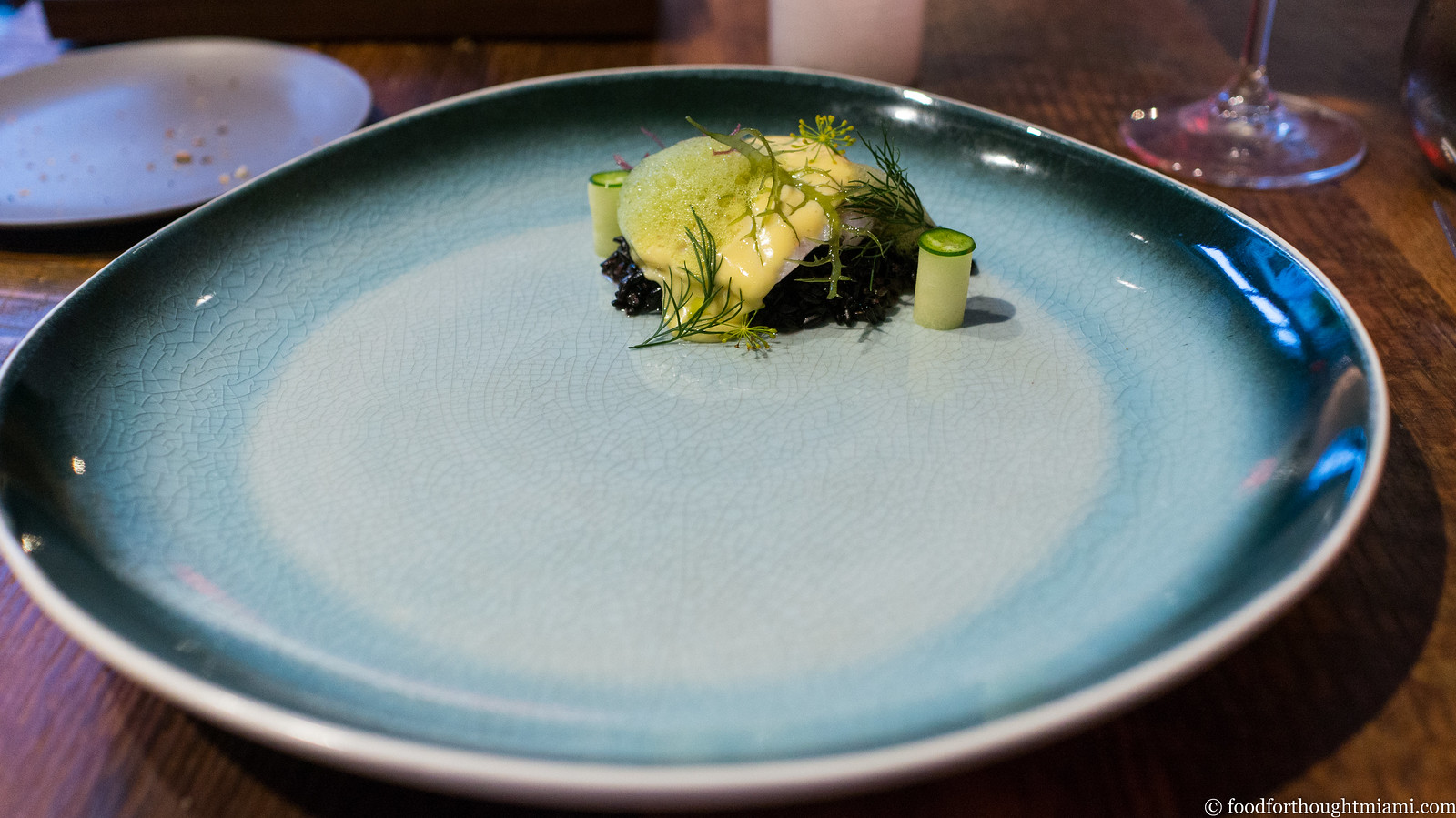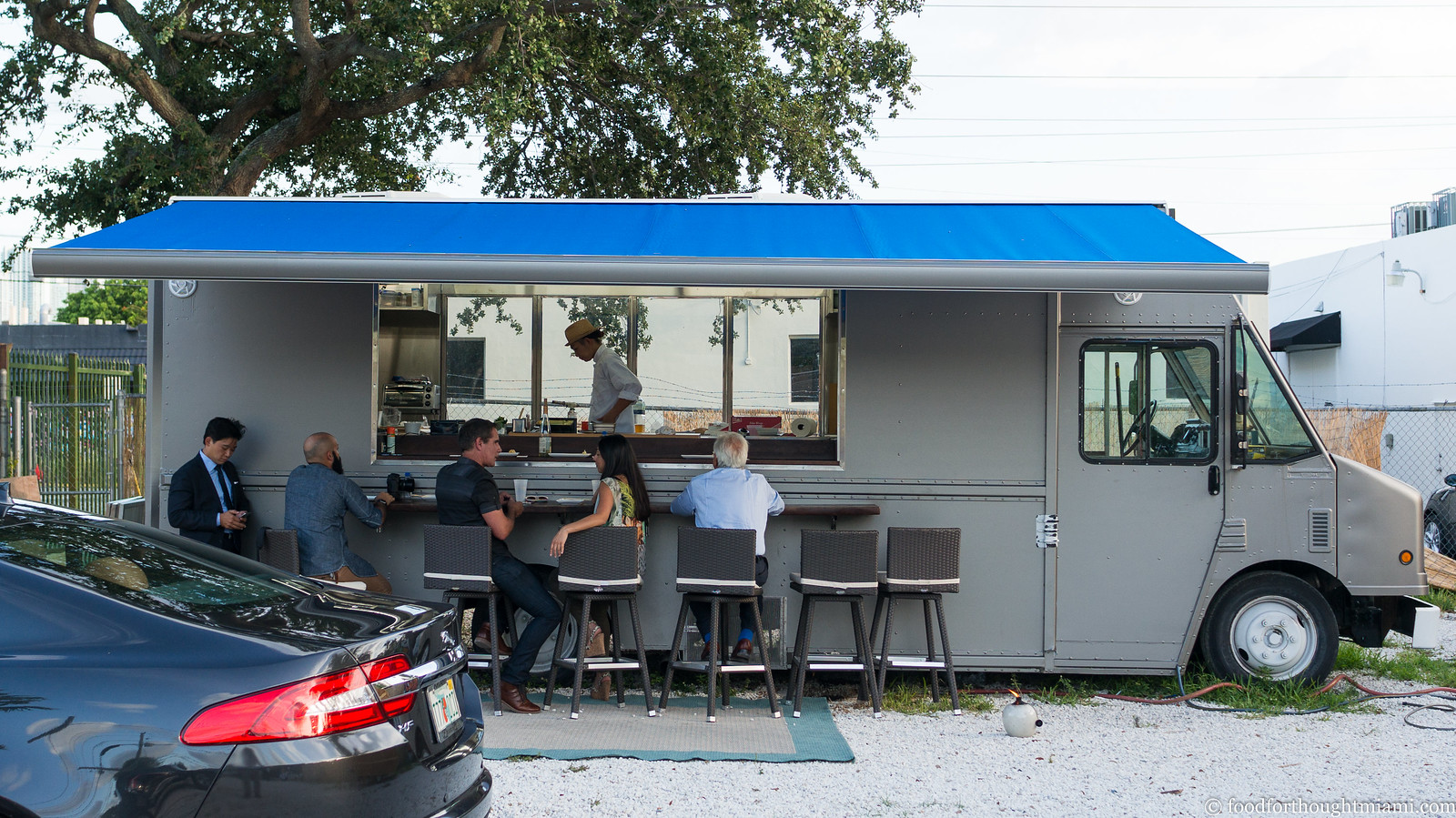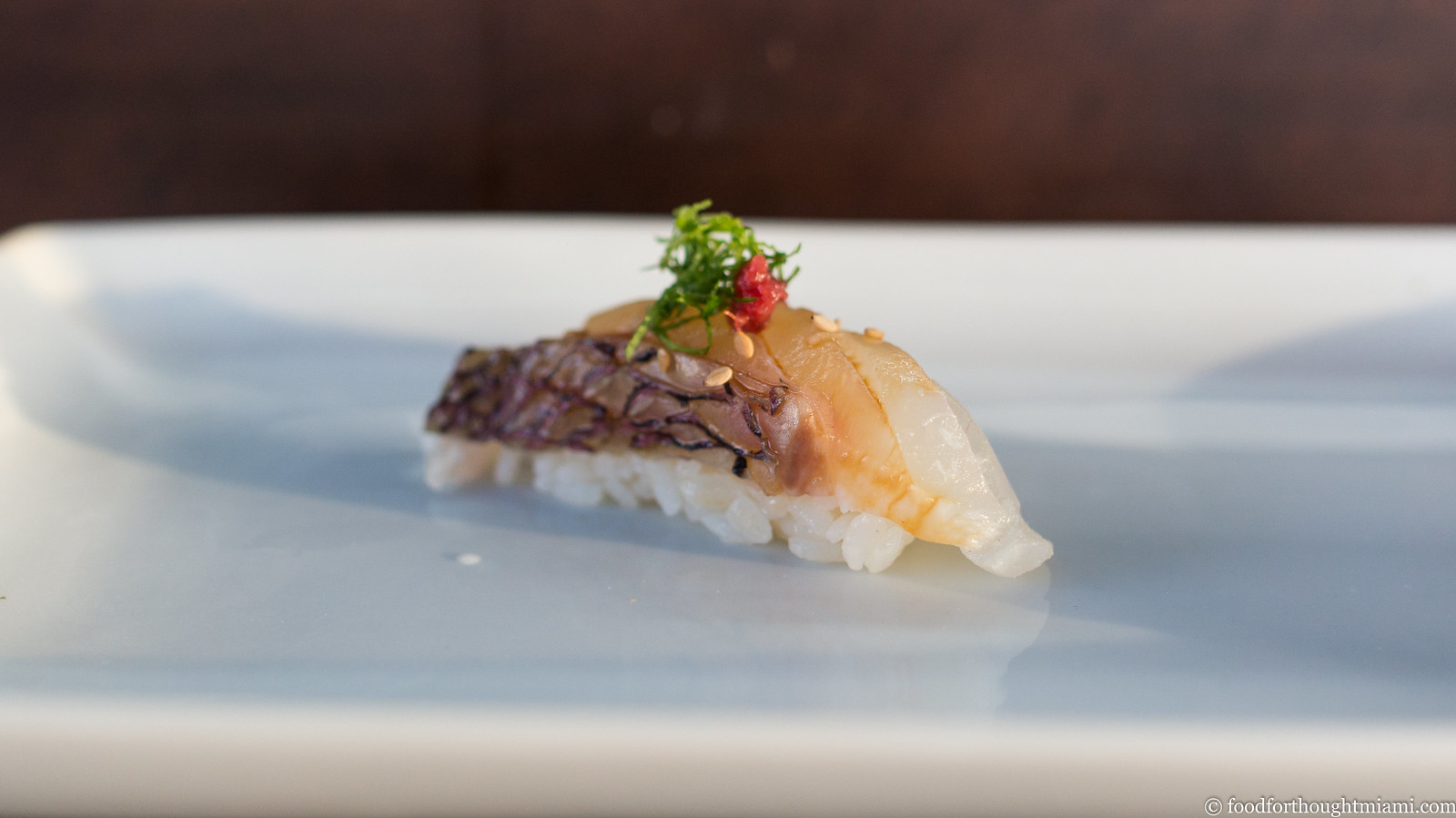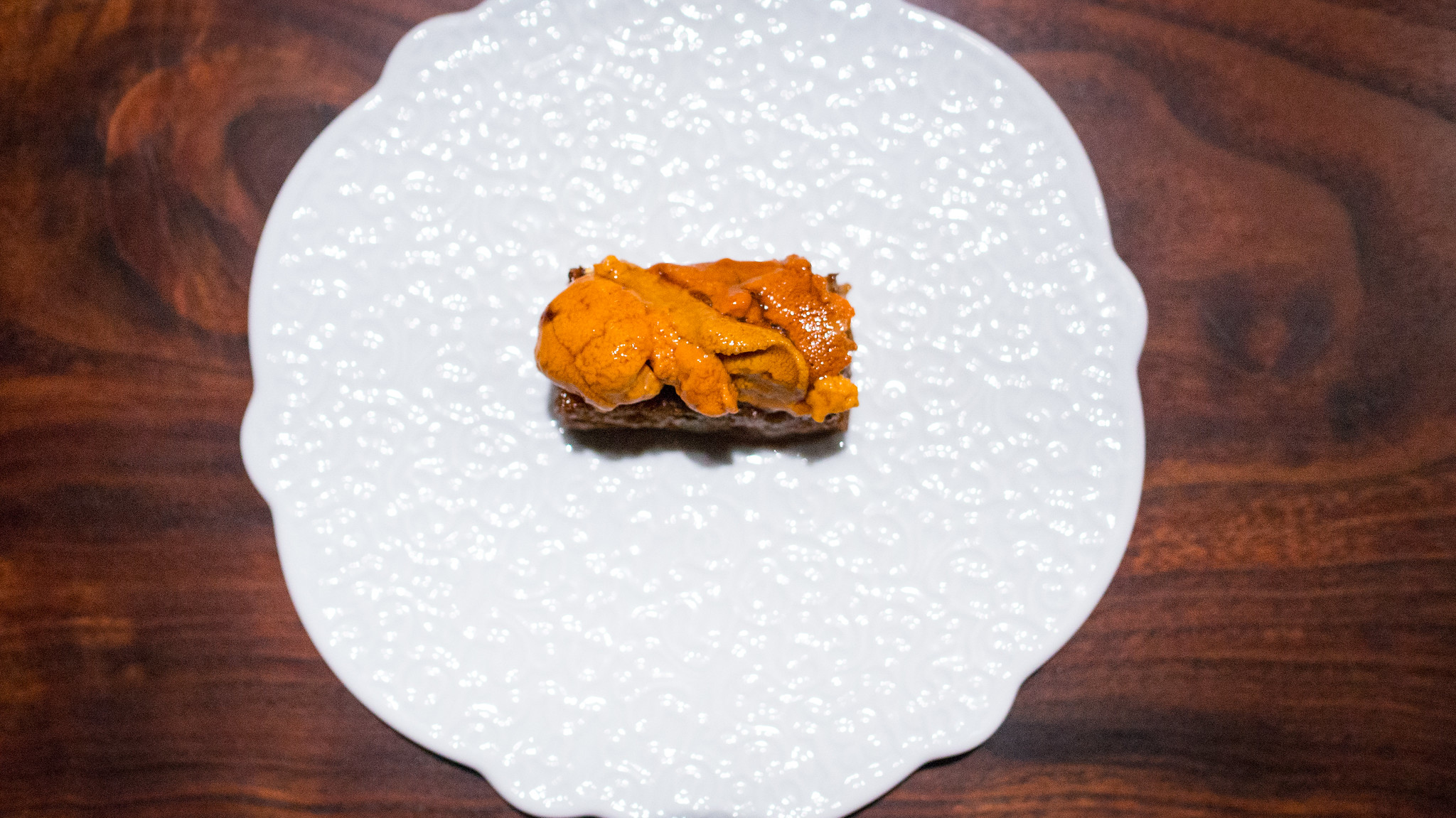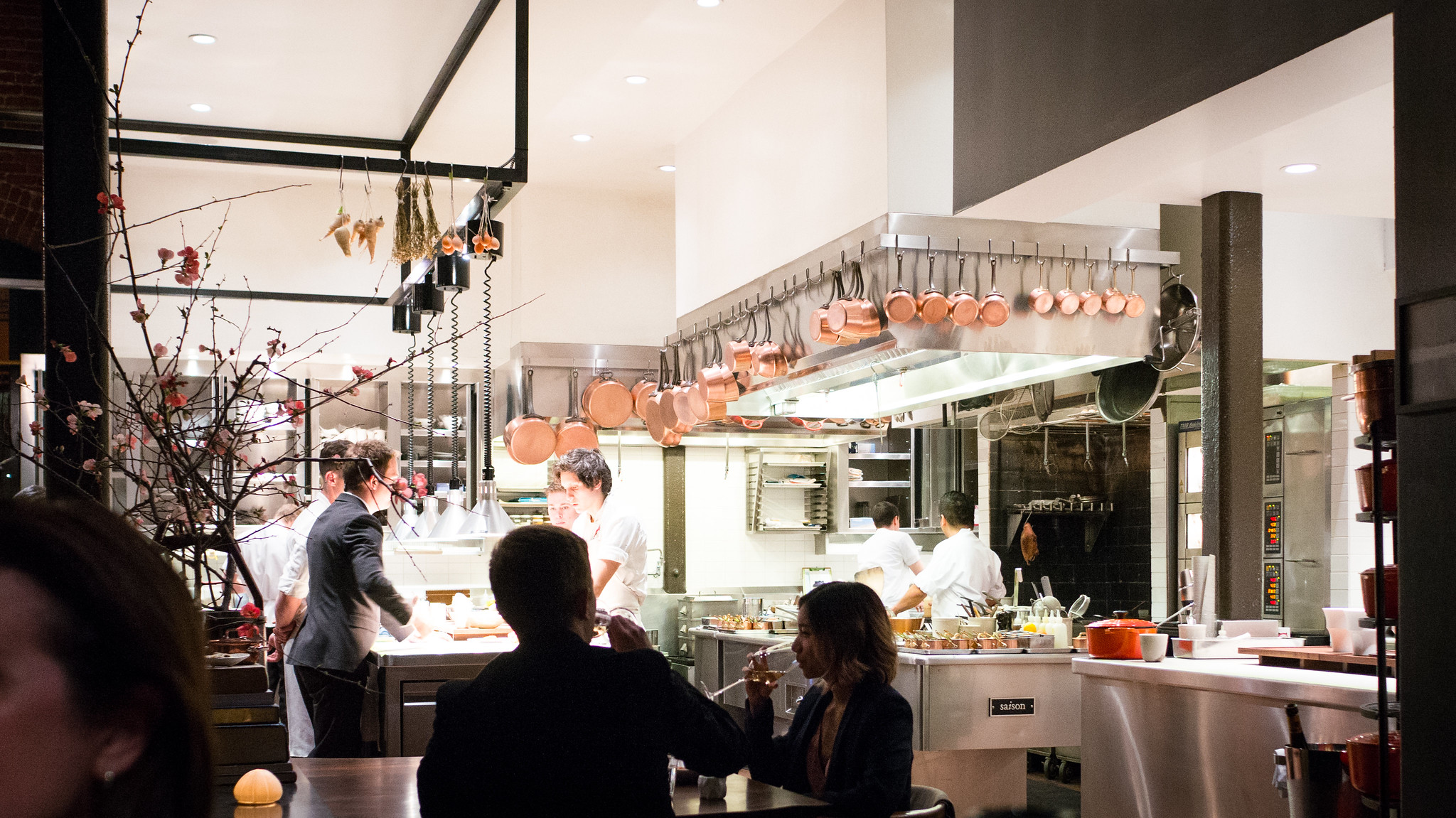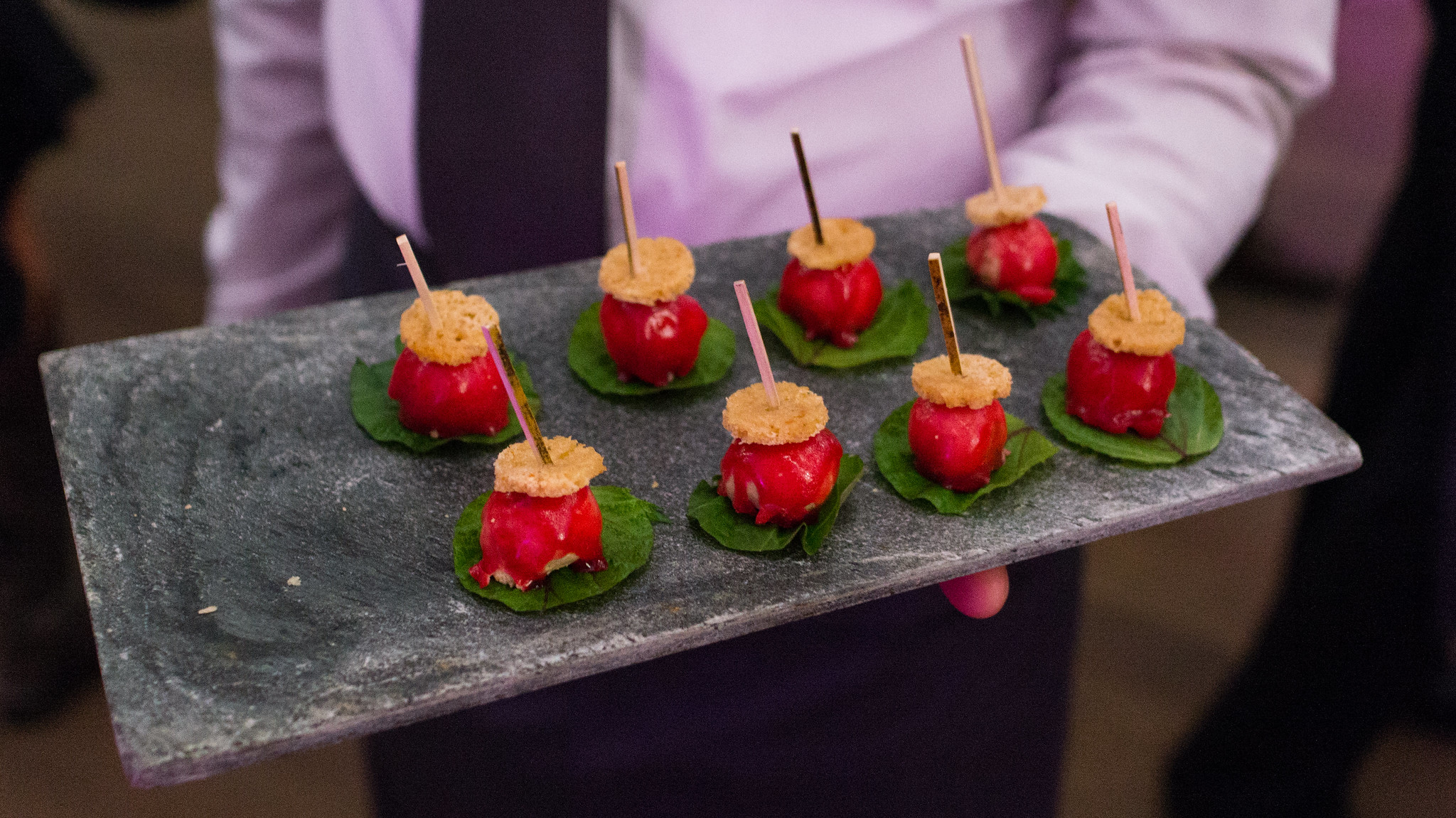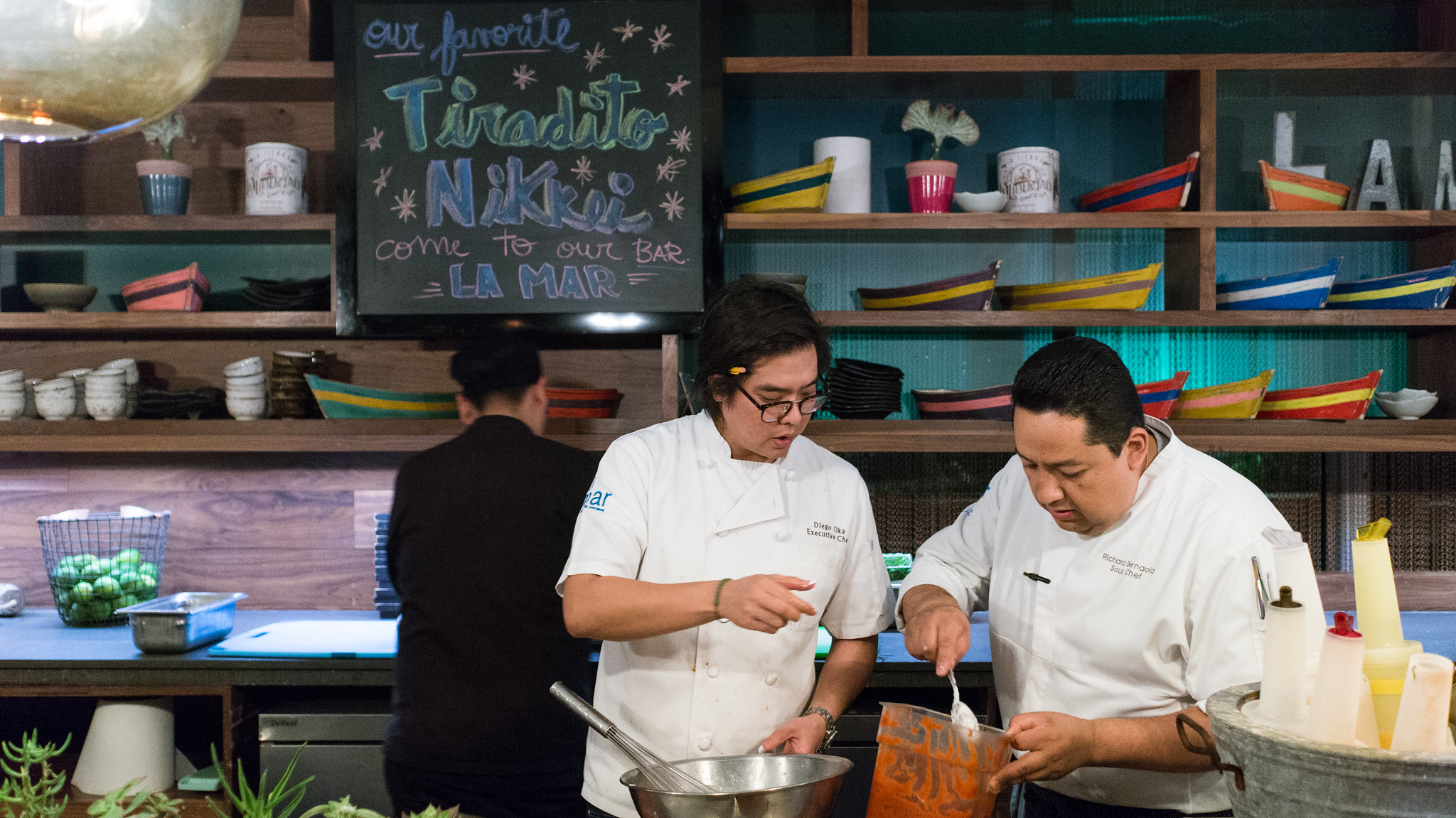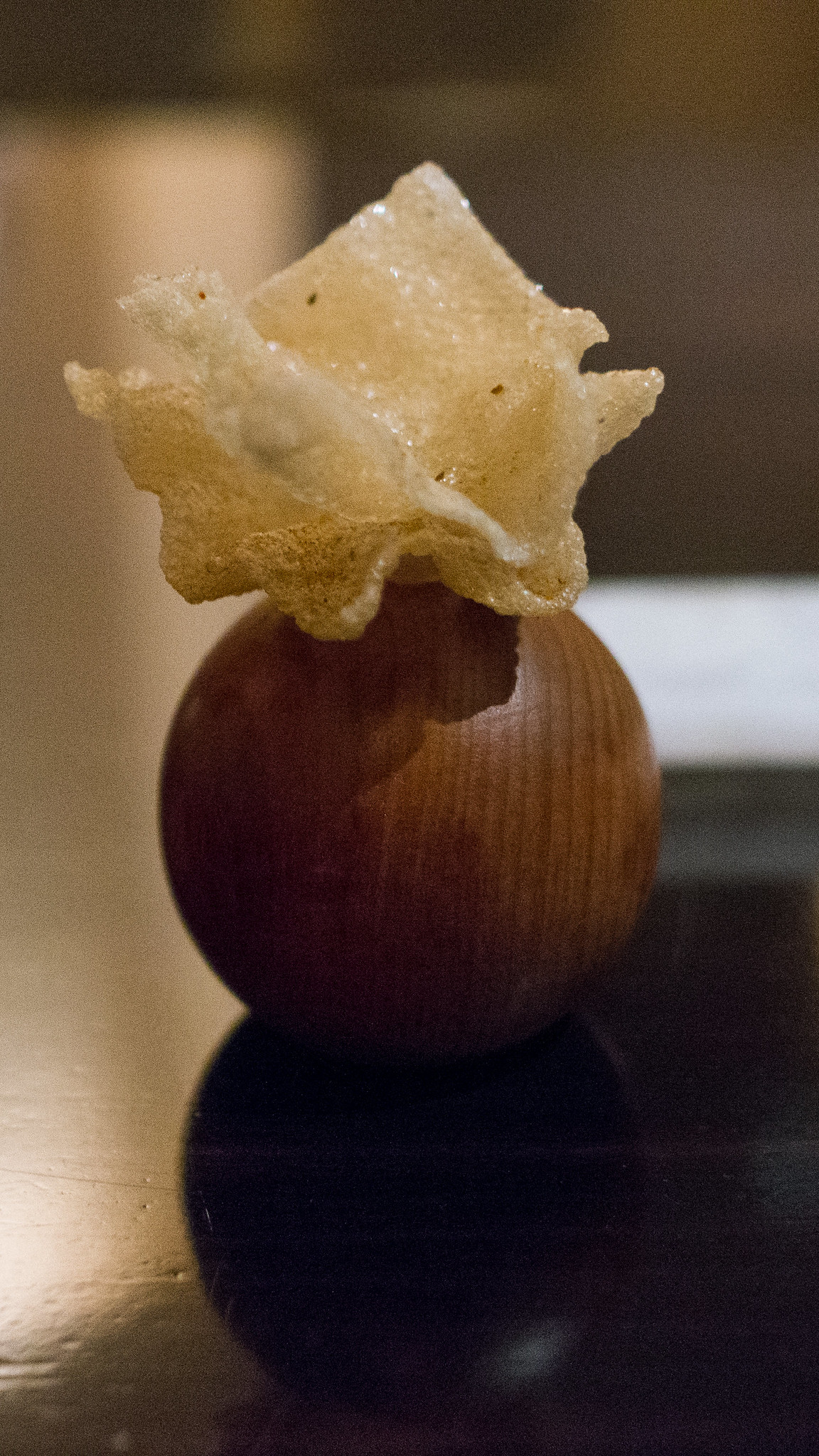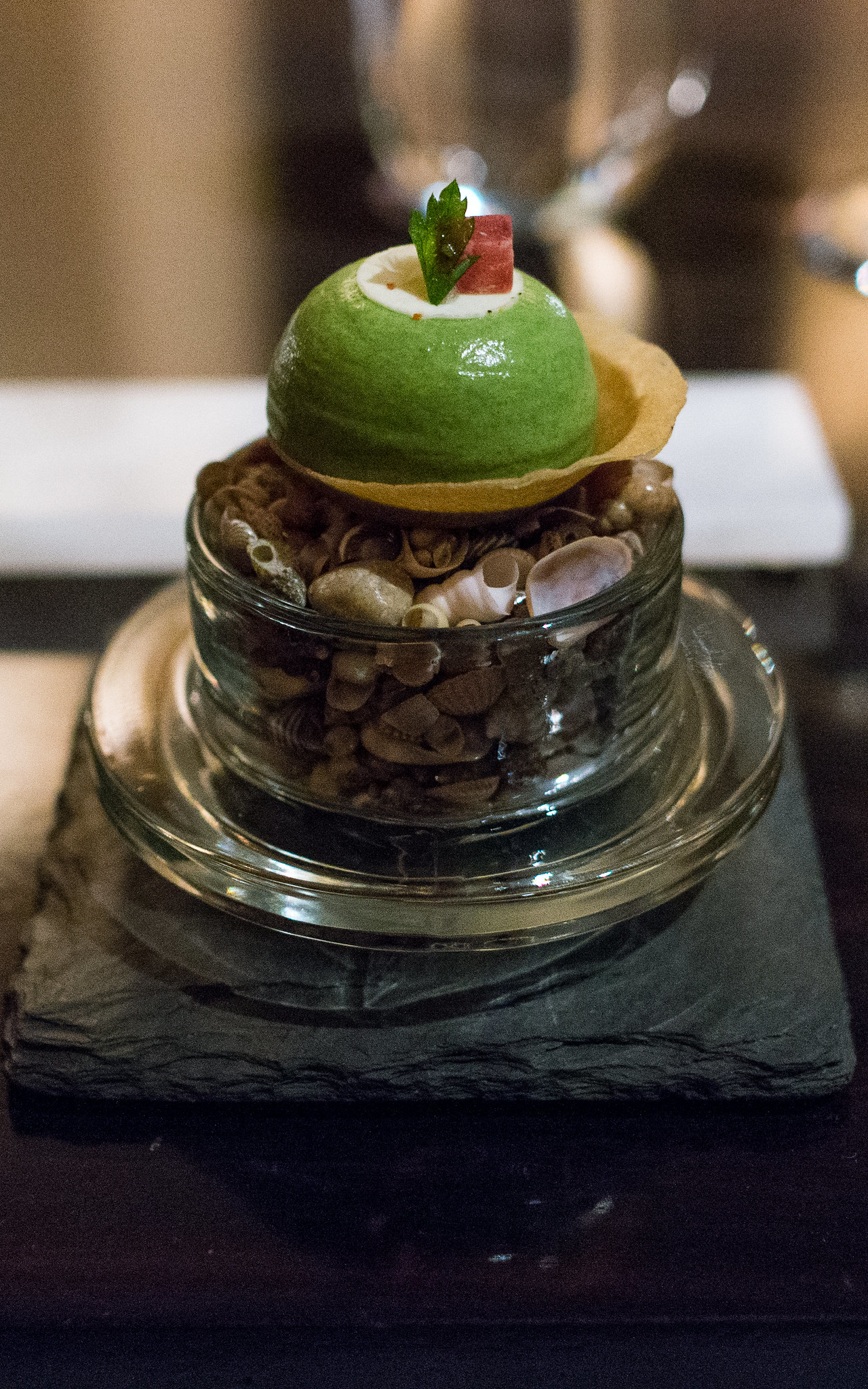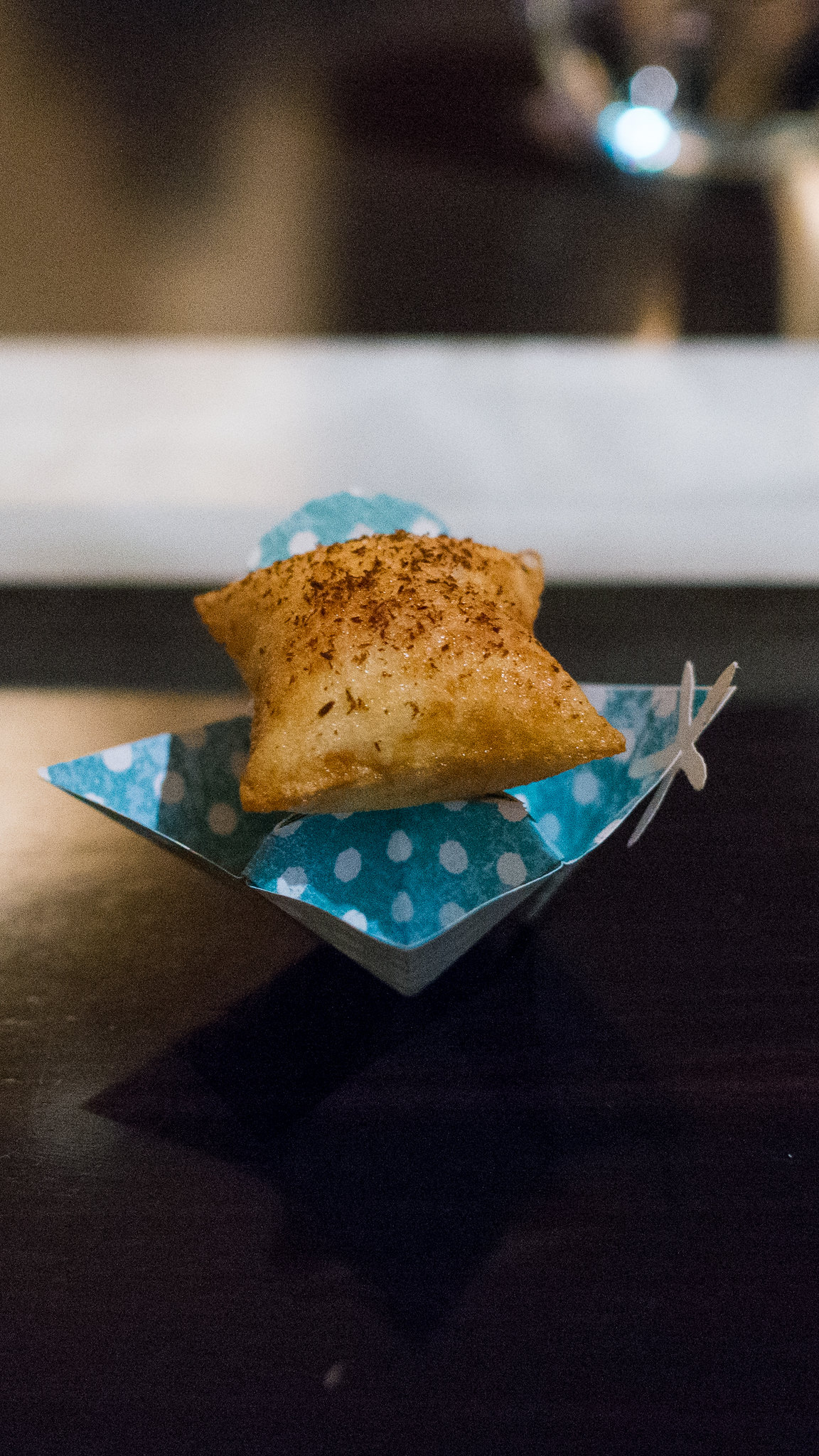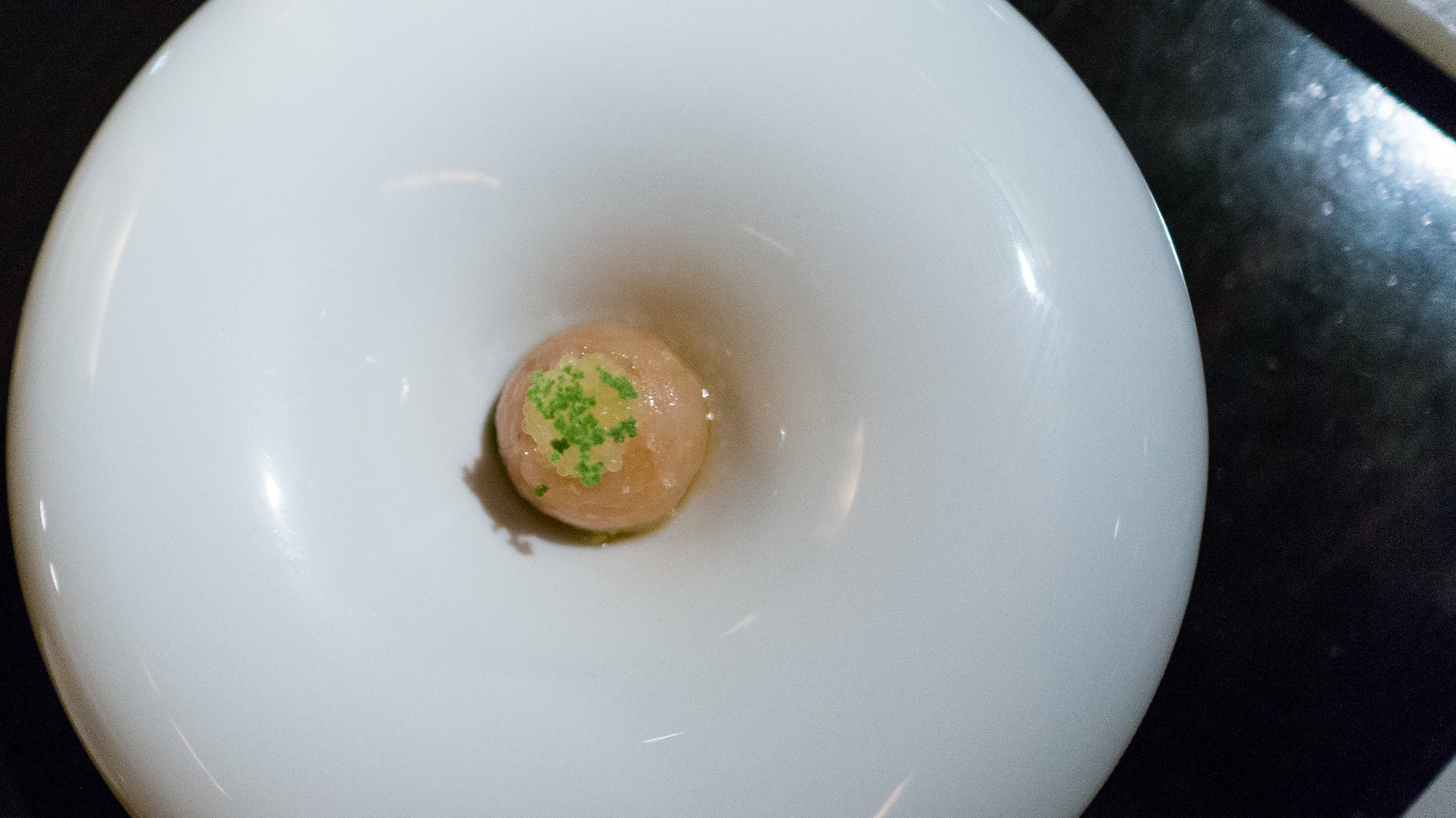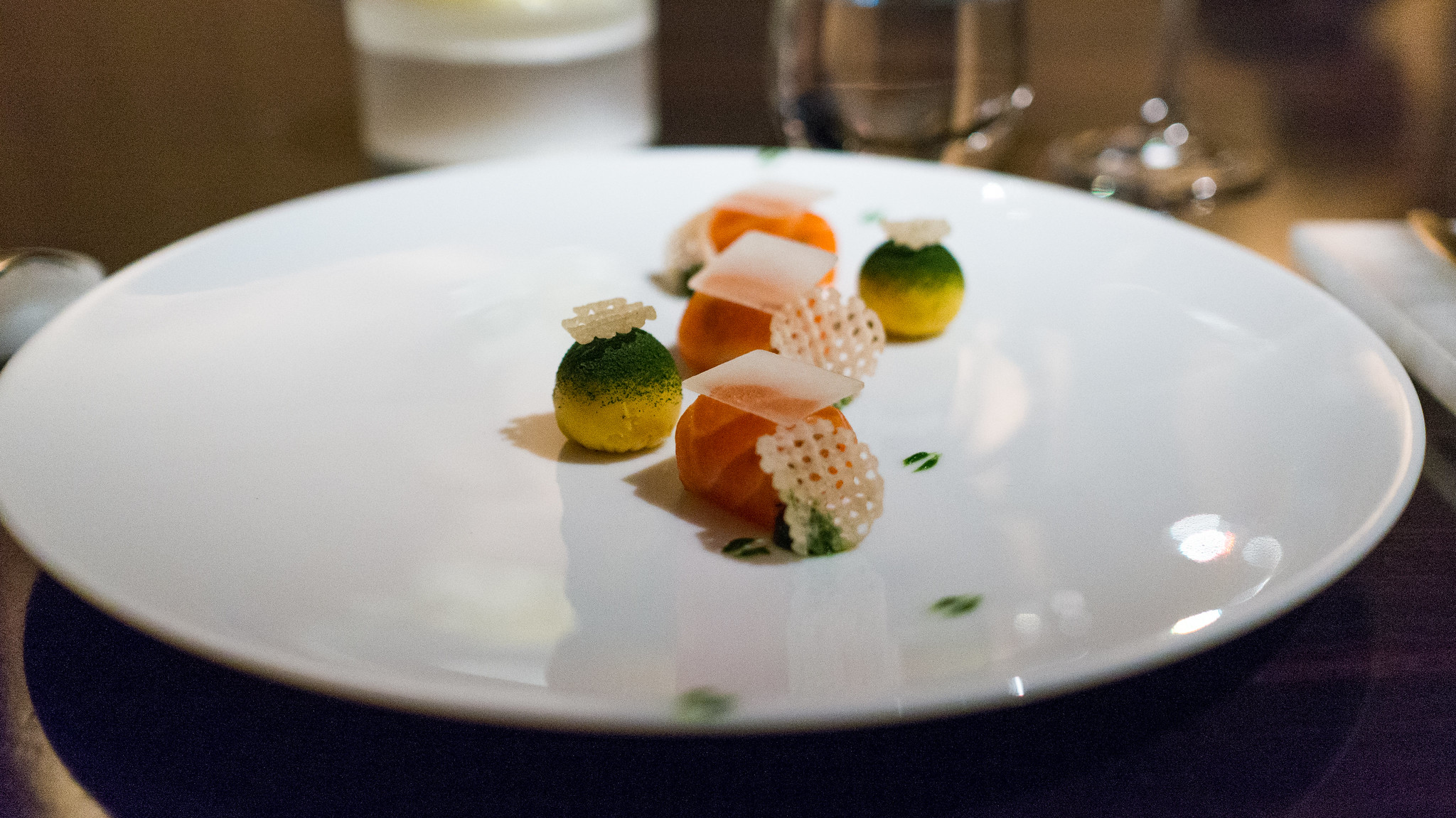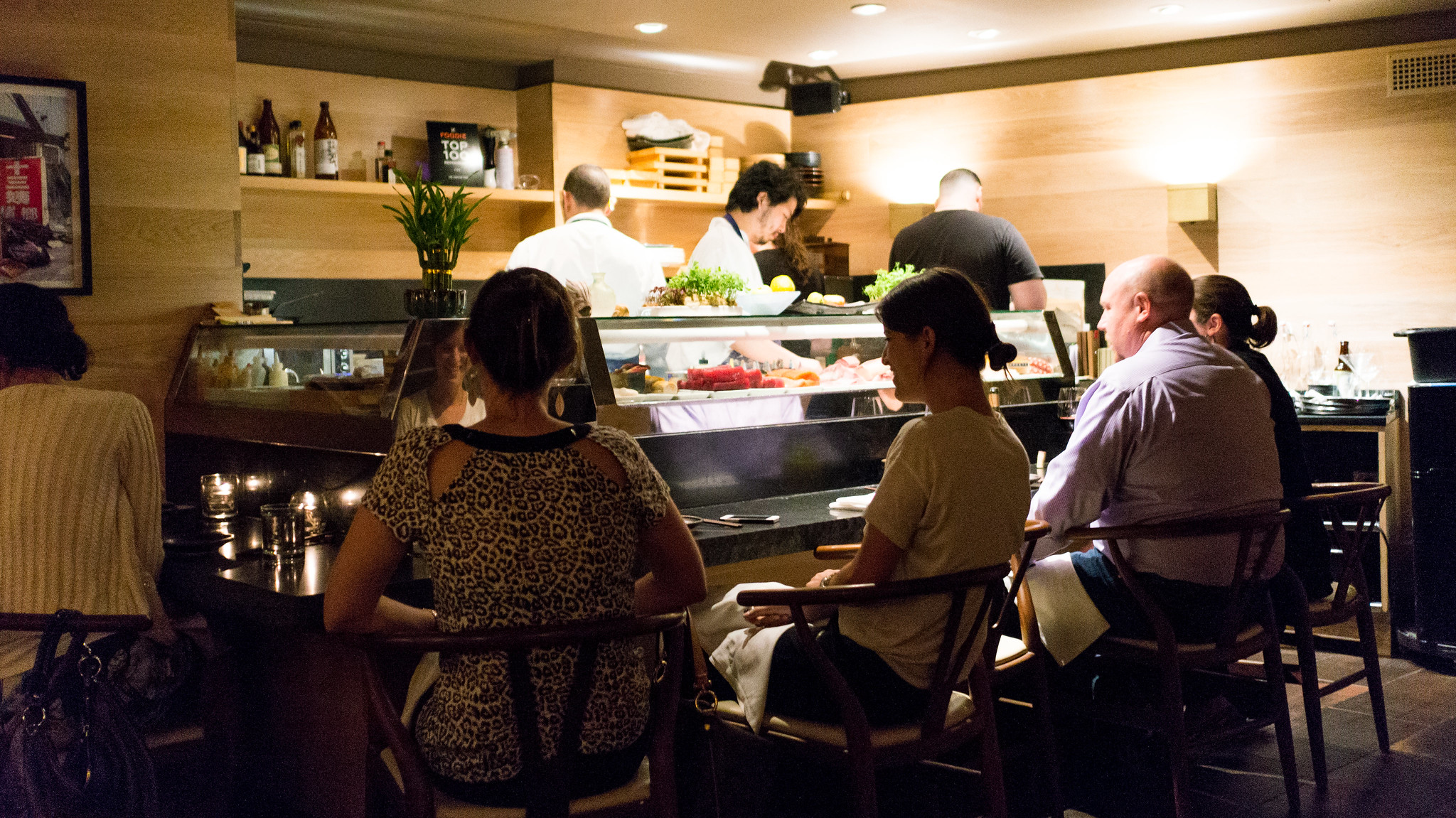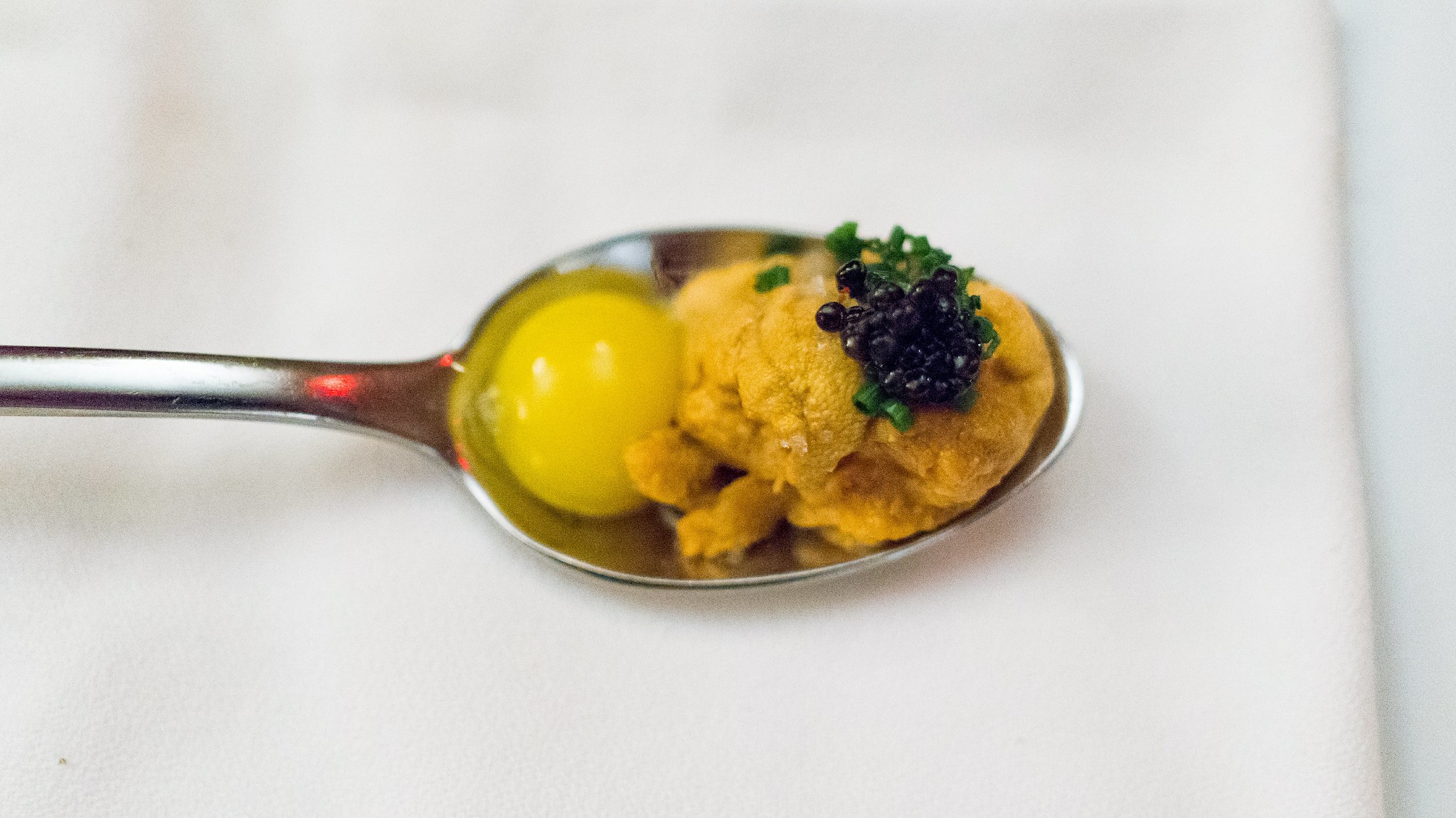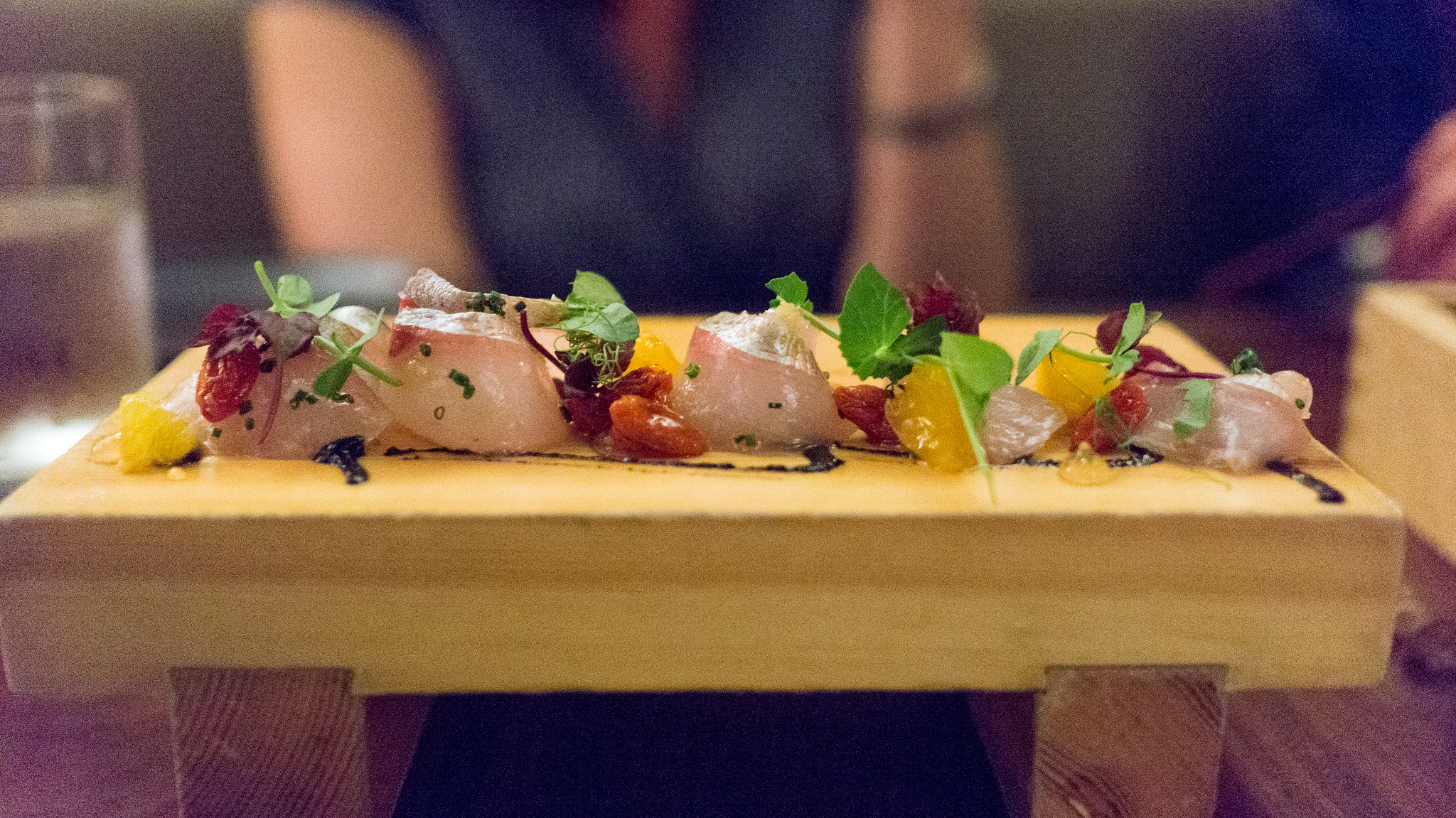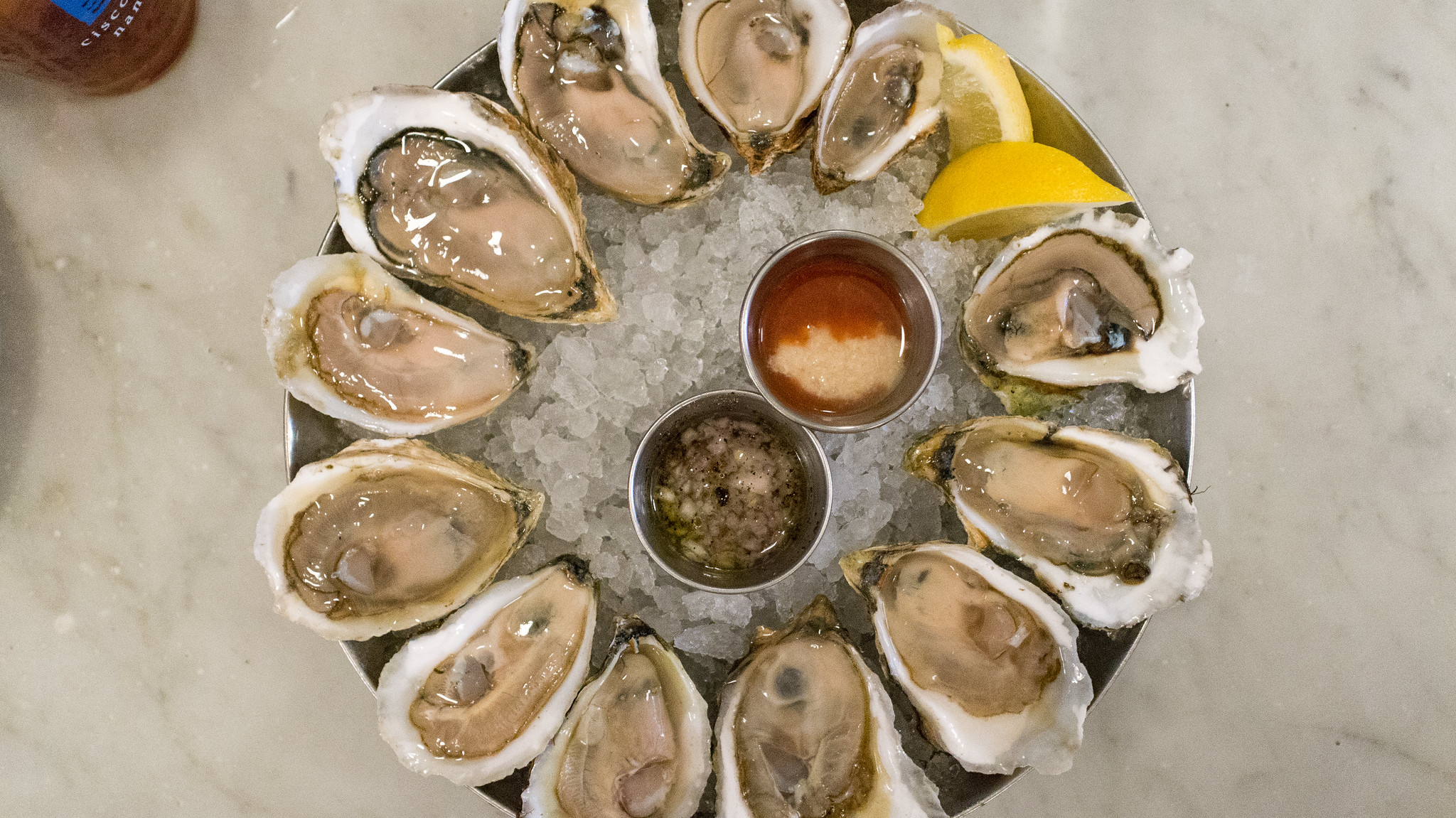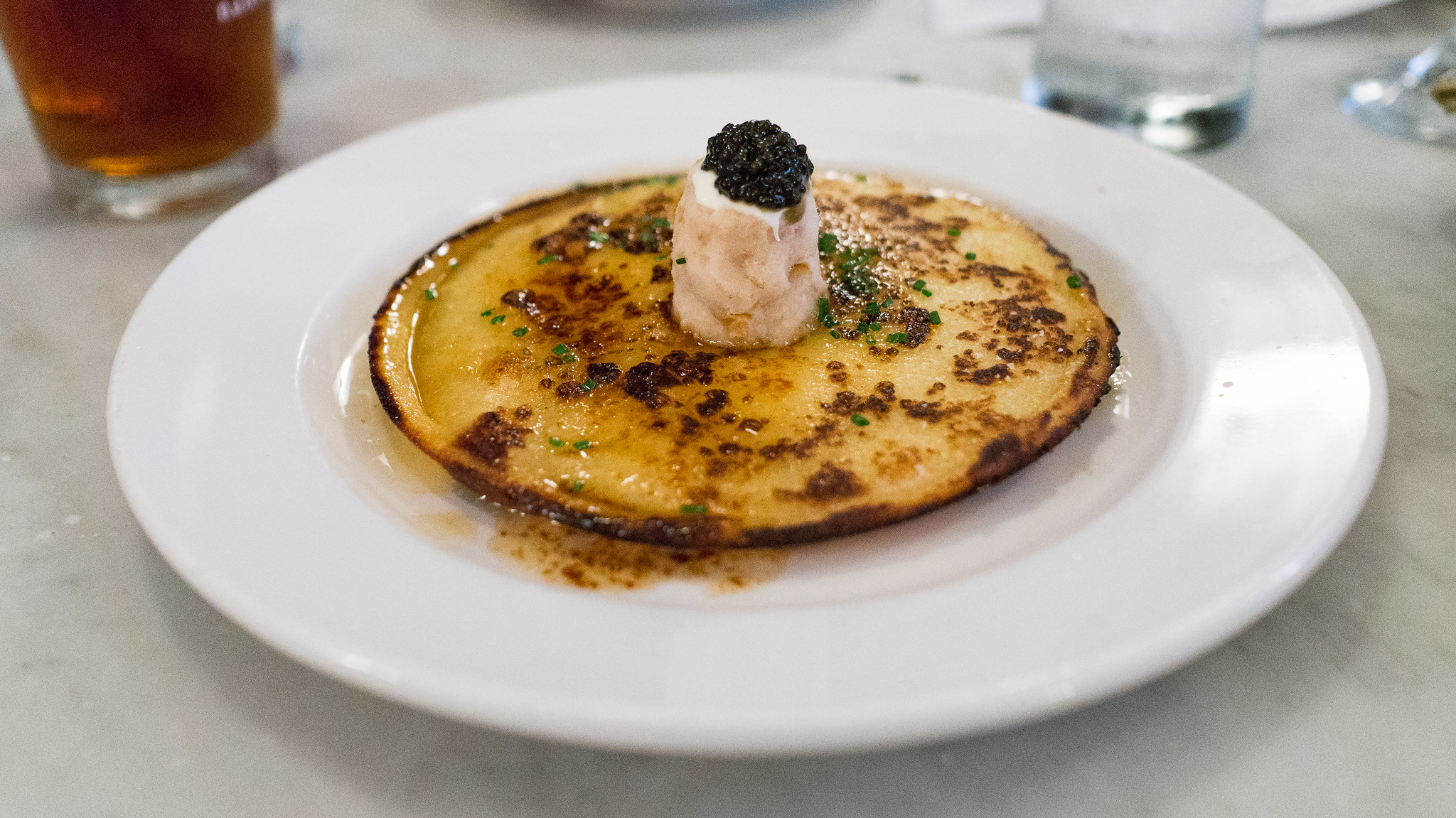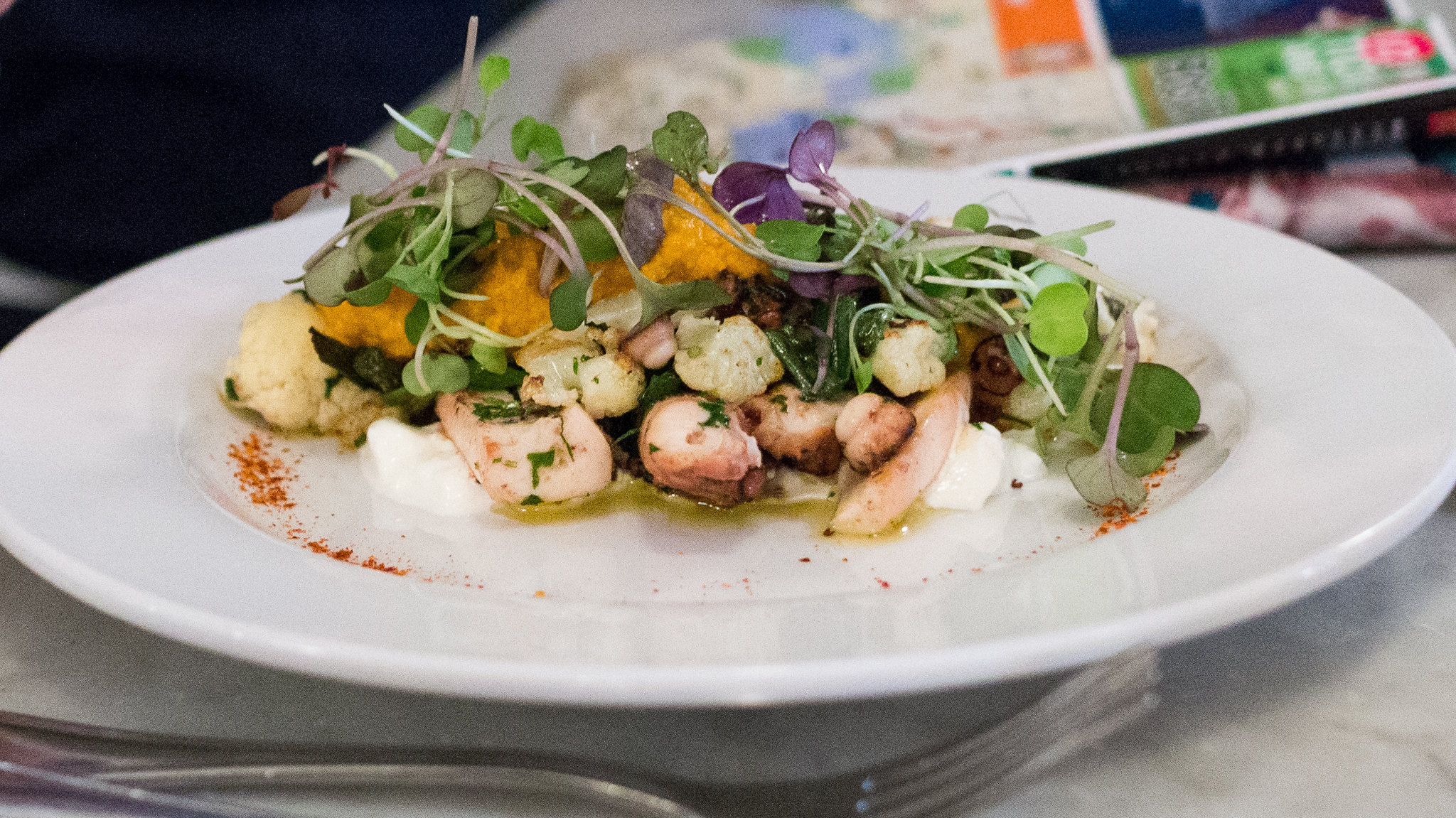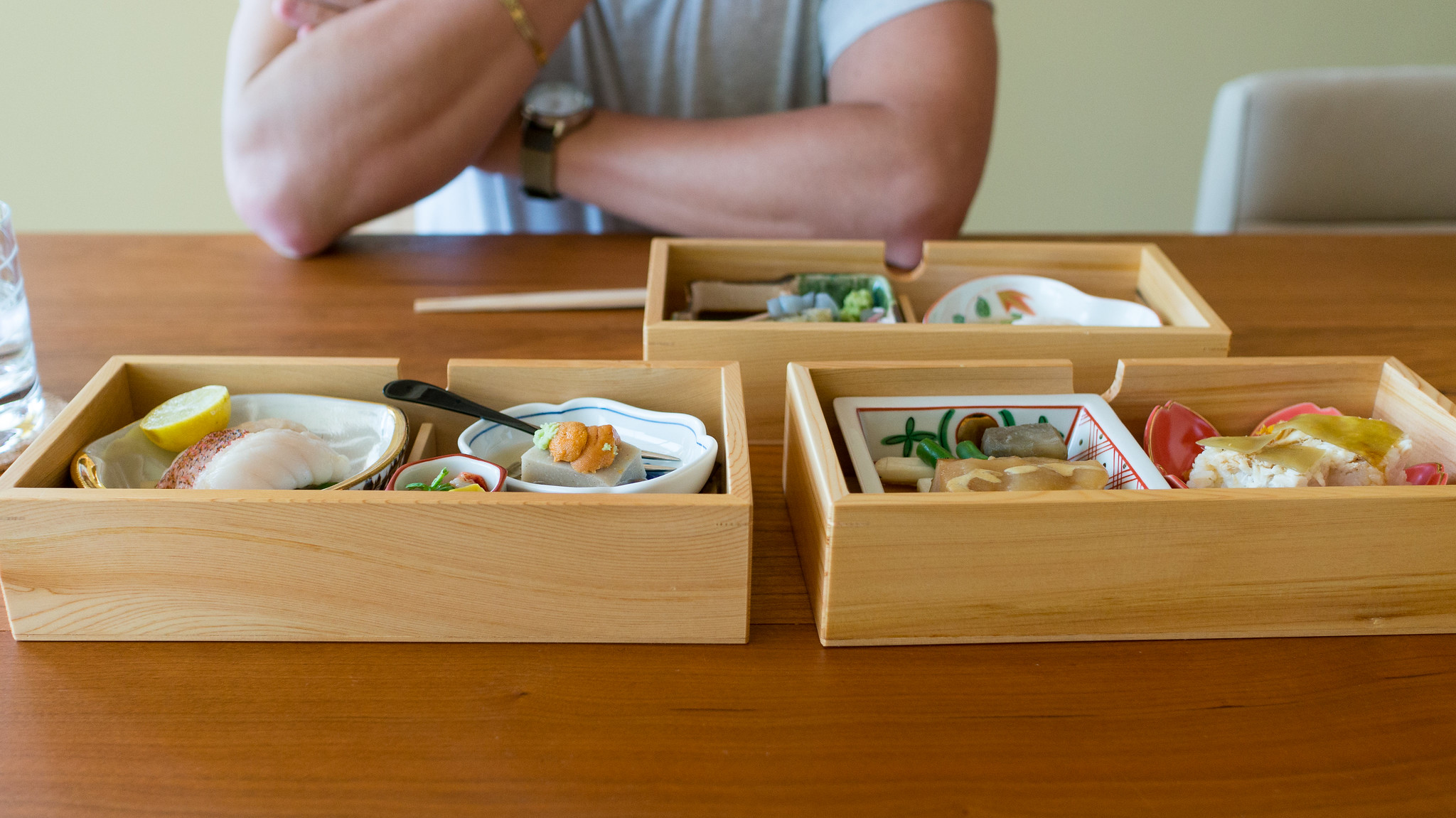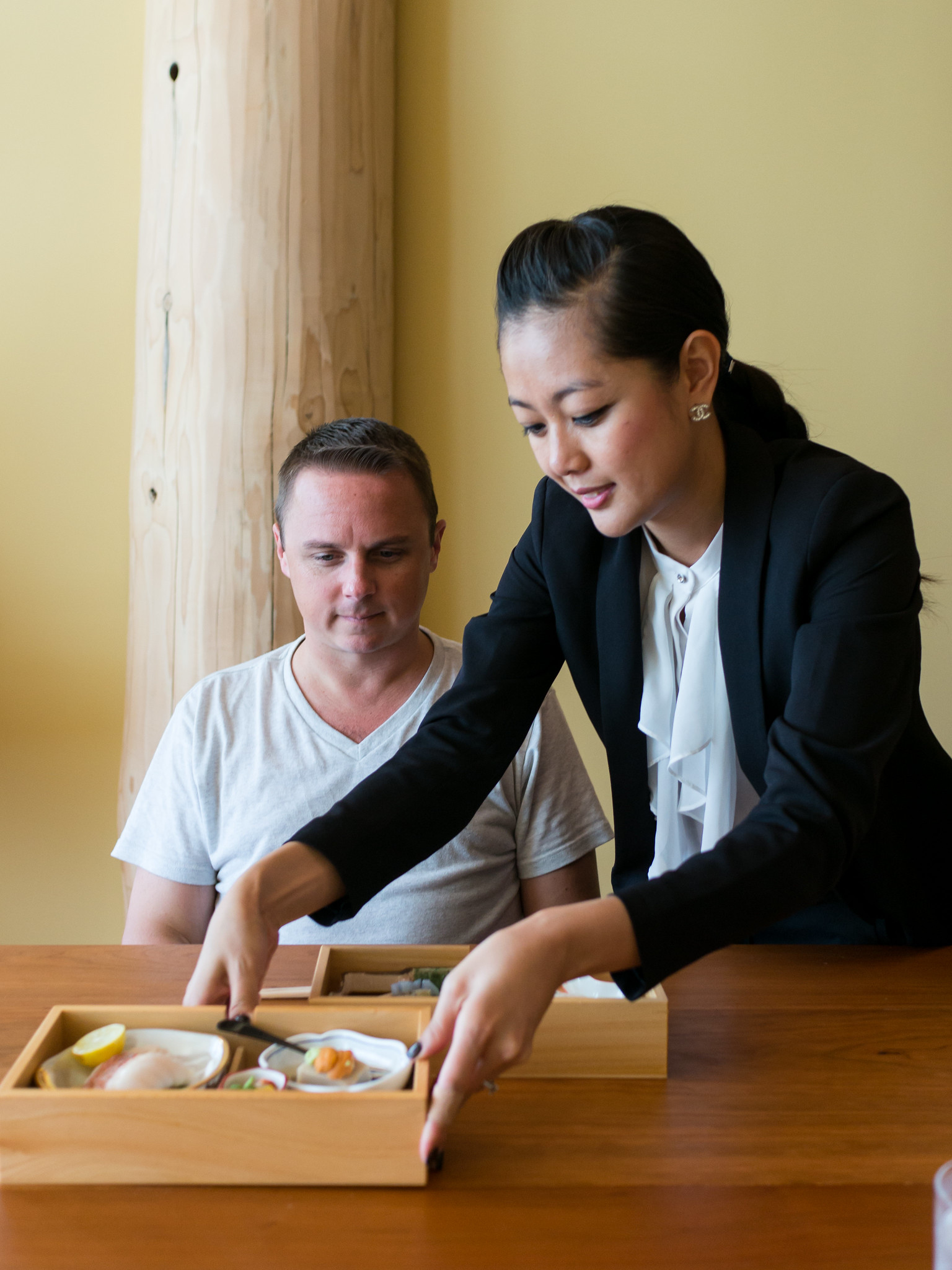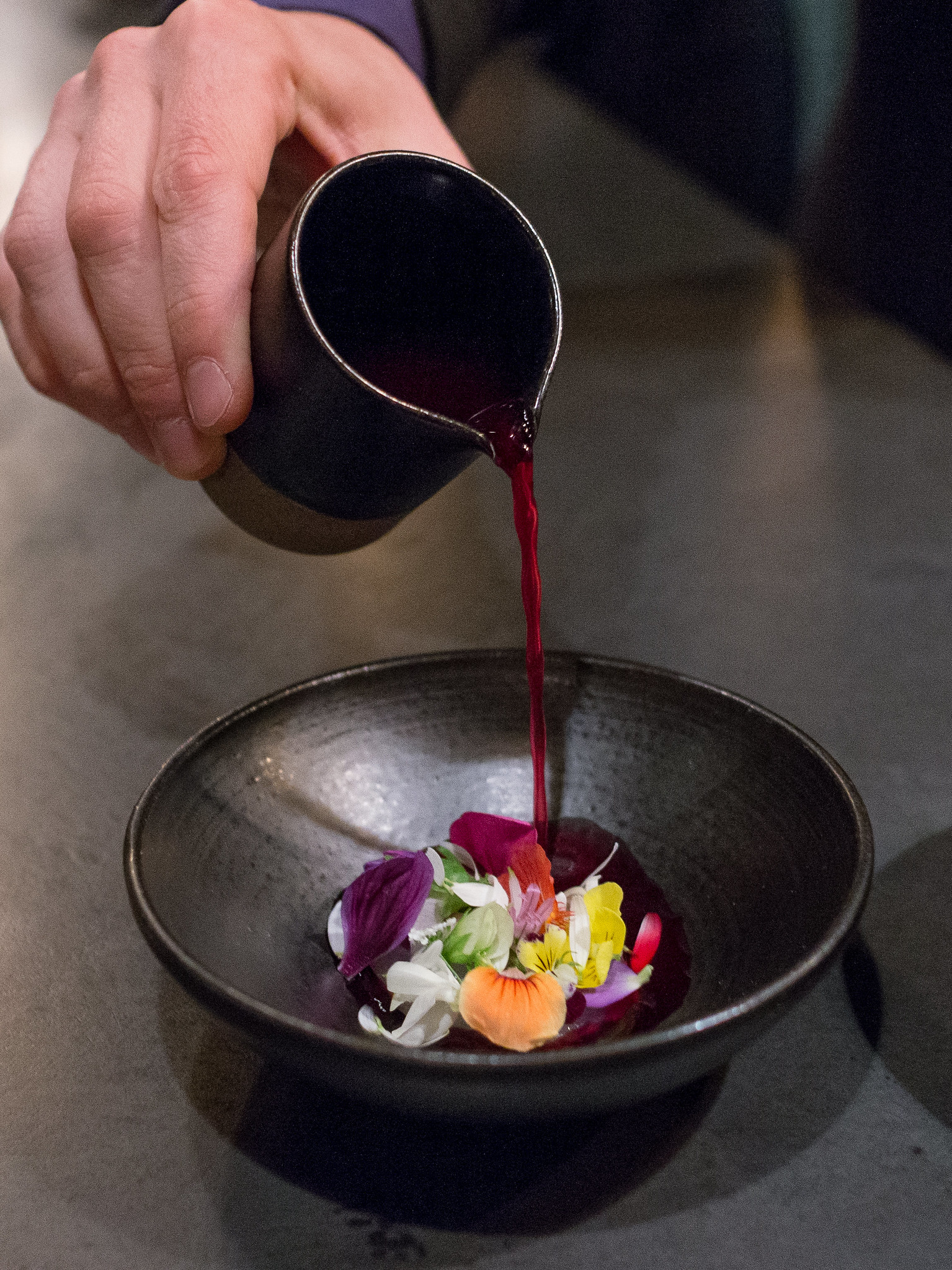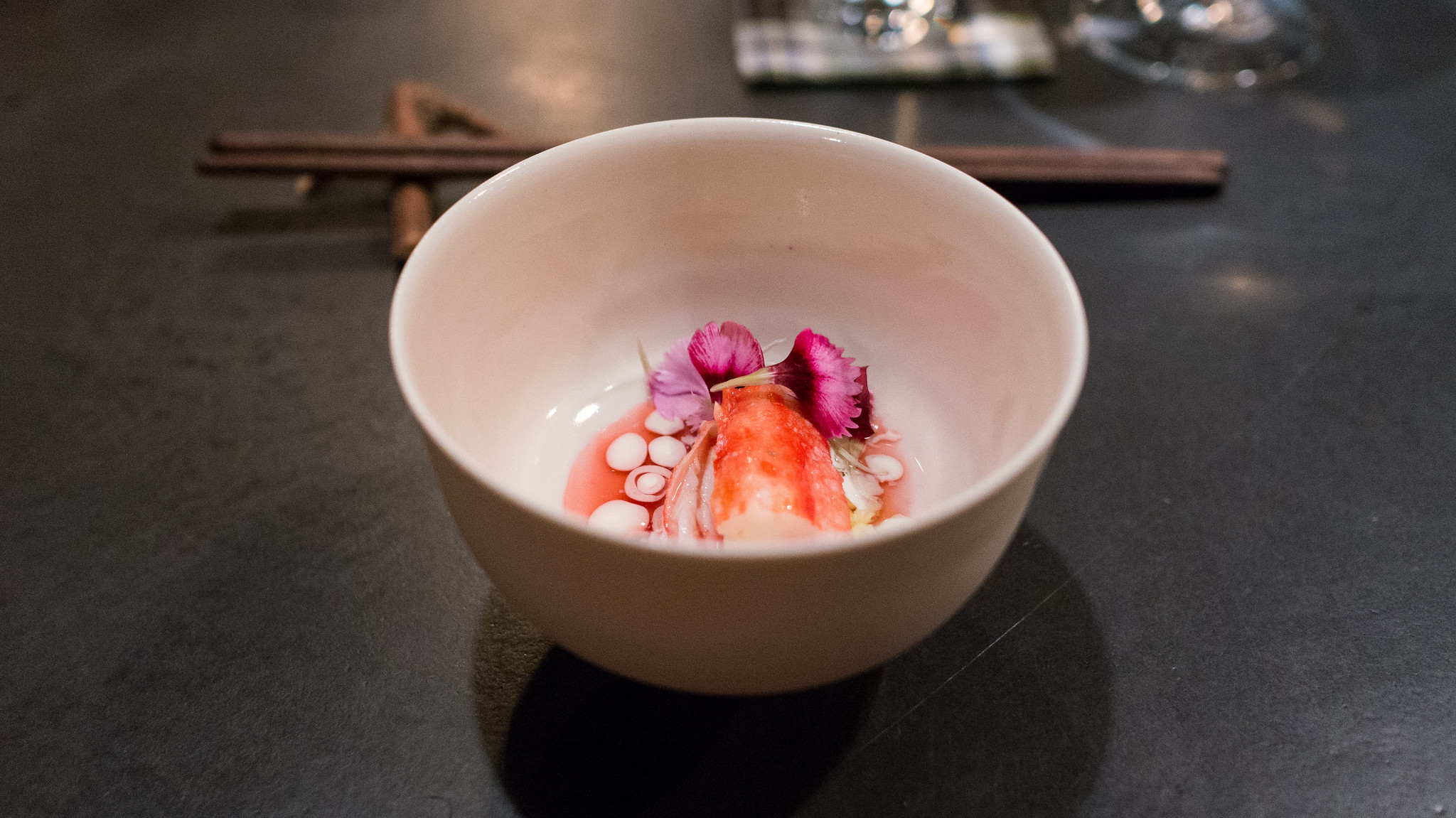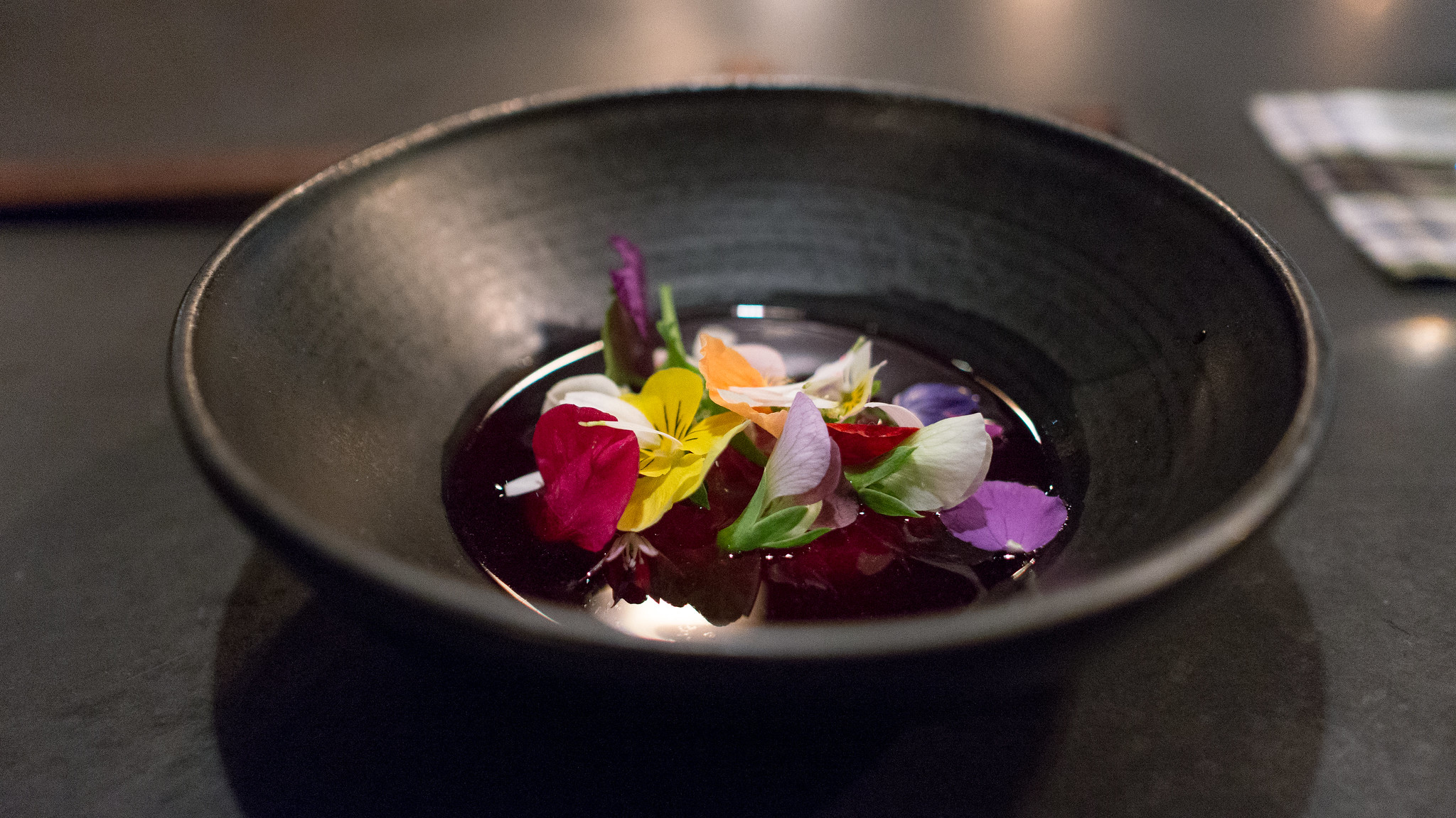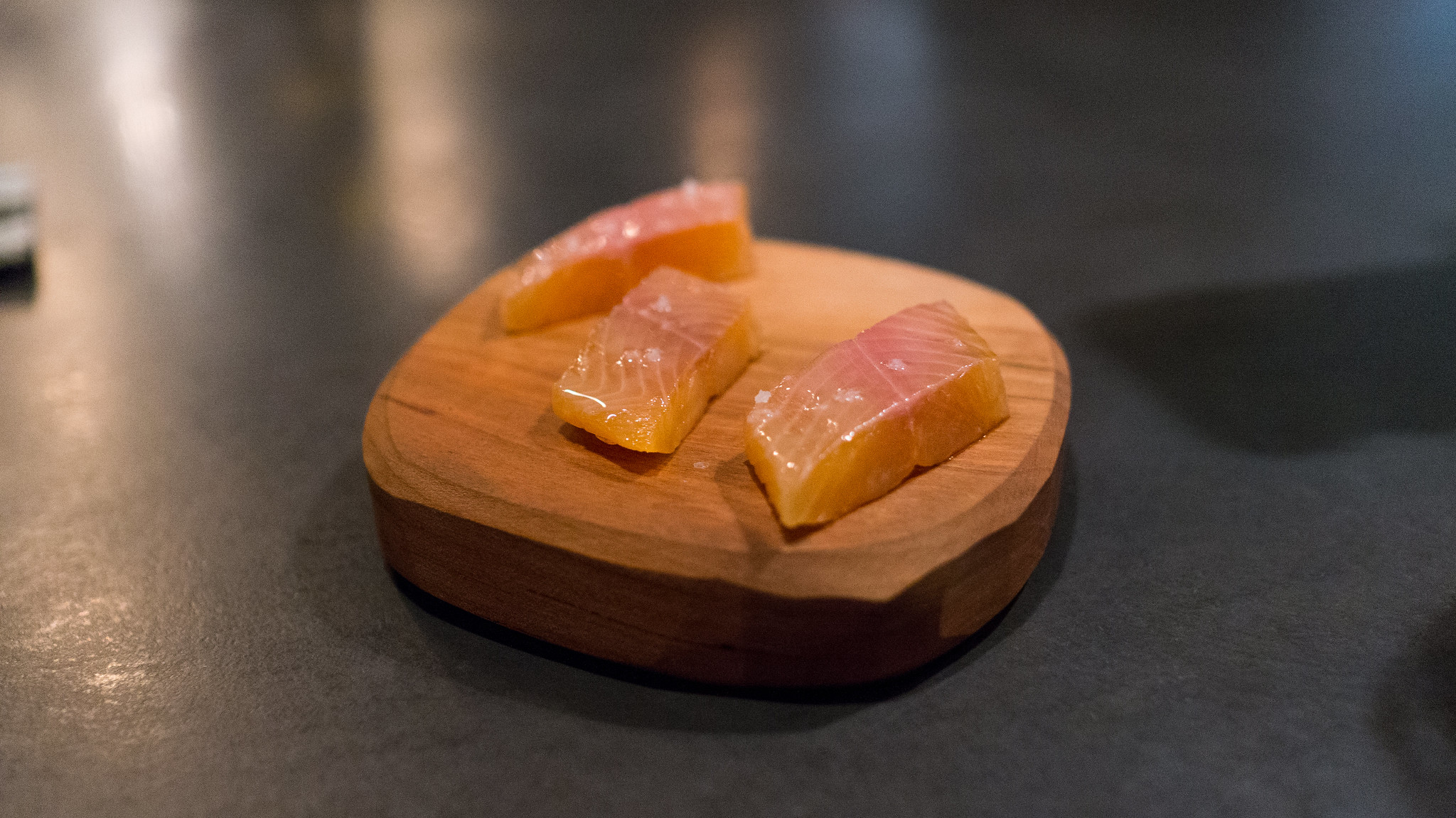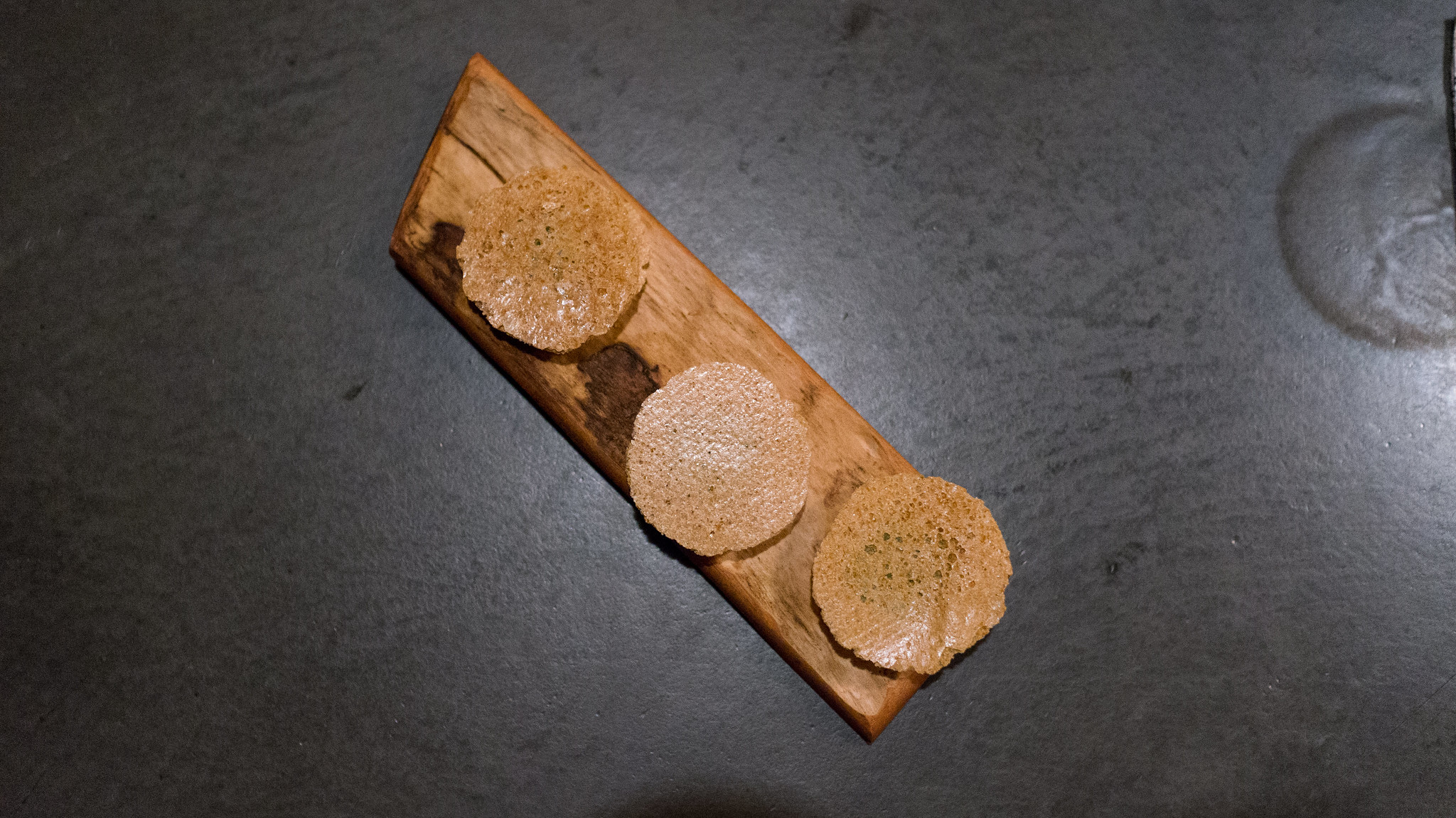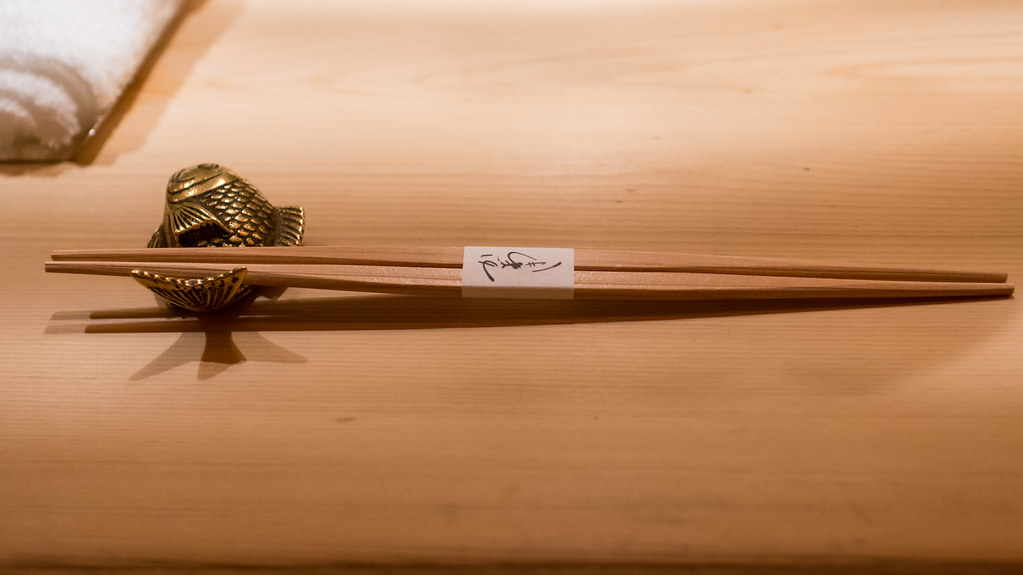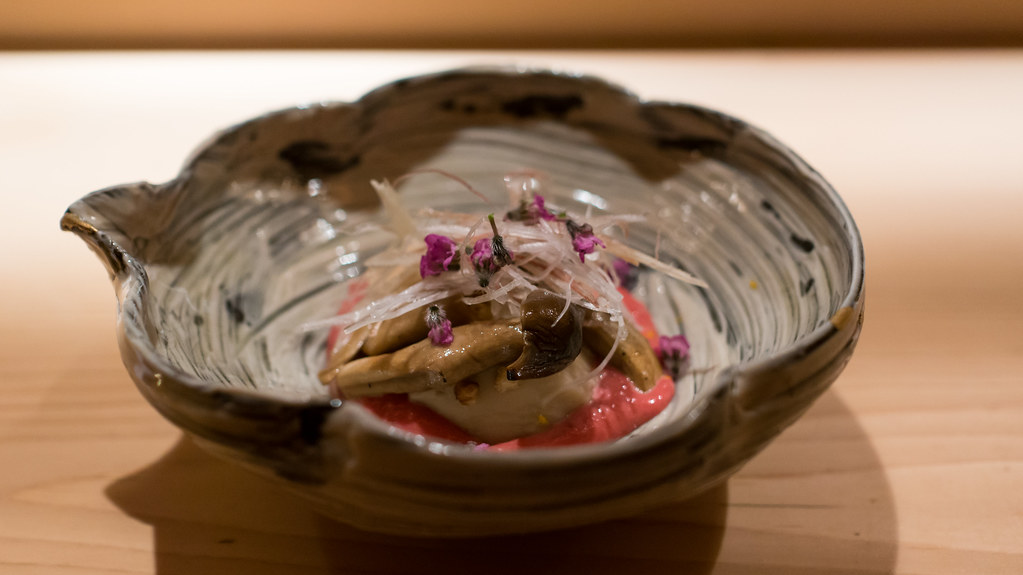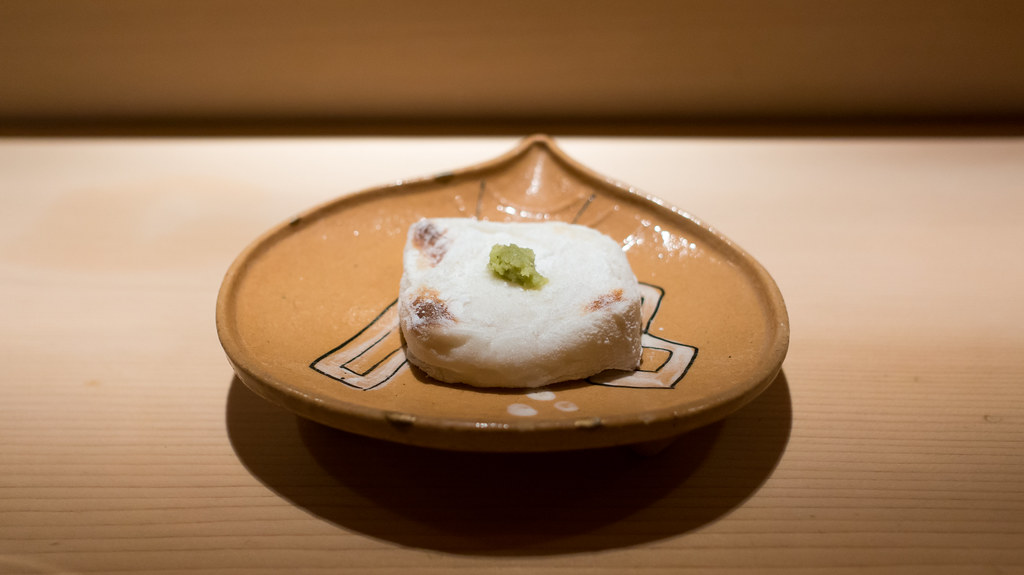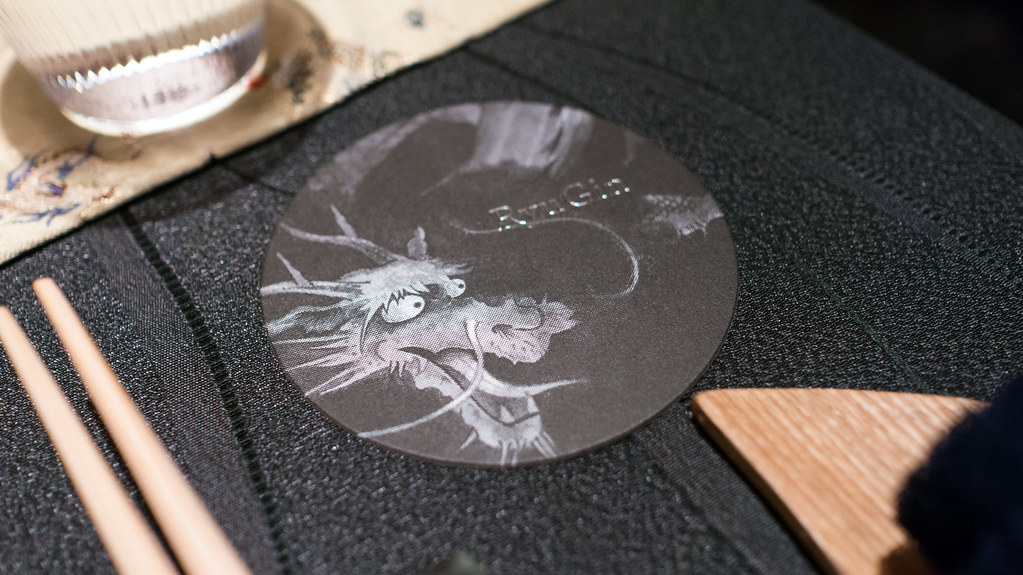I've been waiting a long time for Bradley Kilgore to get a place where he could really do his own thing. We first crossed paths when he was the sous chef at Azul, and we did a Cobaya dinner there with Andrew Zimmern as a guest (who nicknamed Brad "Wall Street" for his slicked back hair). A brief stint at Exit 1 on Key Biscayne, a longer and more fruitful tenure at Jean-Georges' J&G Grill, and now that time has finally come with Alter.
The menu at this roughly 45-seat venue in Wynwood is all Brad's, honed down to seven appetizers and an equal number of mains. A five-course, $65 tasting menu selected from among those items is a good way to try a lot of it at once. That's what I did for my first visit, with a couple add-ons.
Cheeks are like the pork belly of fish: richer, fattier, moreish. This grouper cheek is meaty but giving, substantial enough to stand up to the intense shoyu hollandaise draped over it like a velvet robe. Various seaweeds and flowering dill are scattered about, like it just washed up on a black sand shore (that's actually creamy black rice). A couple twists of cucumber and thin rounds of chile pepper provide a bit of palate-cleansing snap.
It doesn't just look like a seascape. It tastes like one too, but with more butter and umami. It was the best thing I ate last week.
(Full disclosure: this course, a small sample of one of the larger entrées, was a gift from the kitchen in addition to the tasting menu; I did my best to make up for it with the tip).
Runner up: the soft egg dish from the same meal. More to come on that after at least one more visit, in order to do a more fulsome write-up.
You can see all the pictures from my first visit in this Alter - Miami (Wynwood) flickr set.
Alter
223 NW 23rd Street, Miami
305.573.5996
Showing posts with label seafood. Show all posts
Showing posts with label seafood. Show all posts
Monday, June 15, 2015
Monday, June 1, 2015
first thoughts: Myumi Omakase Sushi Truck - Miami (Wynwood)
For a long time, I've been bemoaning the dearth of good sushi in Miami. I'm not even talking about in comparison to what I had in Japan; just good quality fish and properly prepared rice is frustratingly difficult to find.
On the very high end there is Naoe, but it requires a commitment of at least a couple hundred bucks and a few hours. I'm also a fan of Makoto in Bal Harbour, but it's become a difficult reservation many days. I've actually got an excellent little spot in my neighborhood, but it's so small, its hours are so limited, and it's become so popular that it is now the Sushi Bar That Shall Not Be Named.
Then what? I had a good meal when I went omakase at Morimoto (pictures here), but the sushi wasn't really the highlight. A few years ago I made a return to Nobu after several years away and the sushi was reasonably good, but the value was entirely out of whack, as has always been the case there. I was actually pleasantly surprised by my first visit to the recently opened Soho Bay (pictures here), a Brazilian import that poached a Nobu alum, Ricardo Sauri, for its executive chef. I'll have to go back and try more.
What else? I'm not nearly as enamored of Matsuri as some folks are. I've got a couple izakayas I love – Hiro's Yakko-San and Su Shin – that serve sushi, but it's not their strong suit.[1] I'll go to Pubbelly Sushi for their reimagined Japanese gastropub stuff – a good rendition of tuna poke, the hamachi ceviche with tostones, the ridiculous but delicious pork belly and clam roll – but it's also not a place to go to for traditional nigiri. Everything else I've tried is crap.
Enter Myumi. It's not your typical sushi bar. In fact, it's a truck – a converted FedEx delivery truck, currently stationed in a lot in Wynwood. Which I suppose makes a bit of sense: I've read that sushi was originally street food. From that truck, Chef Ryo Kato[2] serves an omakase only (chef's choice) menu with only two choices: do you want to spend $40 or $60?
The omakase-only format means they know exactly what they need to buy, so they buy some very good stuff: fish and shellfish straight in from Japan, uni and ikura from Alaska, tuna from Ecuador. Some items get just a brush of shoyu, others more elaborate garnishes. Our $60, 12-course selection went like this:
(You can see all my pictures in this Myumi - Miami (Wynwood) flickr set).
(continued ...)
Tuesday, March 10, 2015
Saison - San Francisco
There are few meals I've looked forward to with as much anticipation. Between the reports from trusted friends both virtual and flesh and blood, the three Michelin stars conferred late last year (which many thought were overdue), and myriad other raves and recognitions, my expectations for Saison were quite high.
Some reputations are so lofty that I fear the reality cannot possibly compare. But Saison did not disappoint.
Ingredients. Focus. Smoke. Pleasure.
These are the words that keep coming to mind as I look back on our meal.
Ingredients: With a menu that uses primarily seafood and vegetables, prepared in a minimalist style, every item that makes it to the plate has been selected with fanatical attention and care. Many are sourced from nearby: sea urchin from Fort Bragg, seaweeds from Mendocino, vegetables from the restaurant's own farm plot, milk "from our cow."
Focus: Instead of dozens of components thrown together, Saison's dishes have a unity of purpose: nearly every course is about one thing, how to bring out, concentrate, and enhance its flavor. Vegetables are cooked in their own juices, fish are served with sauces infused with their grilled bones, all with the goal of honing and focusing the flavor of the primary ingredient.
Smoke: Almost every dish here is kissed with smoke or fire: grilled over open flame, cooked in the wood-fired hearth, preserved in the smoke that makes its way up the hearth's chimney. This is not just some Luddite counter-reaction to the last decade's increasing focus on kitchen technology. Rather, it's a rediscovery that ancient ways of cooking have powerful ways of highlighting, punctuating, amplifying flavor and texture.
Pleasure: Maybe it's just because these are things that I really like to eat, but Saison's menu feels like it is designed to coddle rather than confront. No doubt, a tremendous amount of thought has gone into the preparation of the dishes; but it doesn't require a lot of thinking to enjoy them.This is not a meal whose purpose is to show you how clever the chef, Joshua Skenes, is. Rather, it's about how much pleasure the diner will take in his work.
(You can see all my pictures in this Saison - San Francisco flickr set).
The pleasure principle kicks in from the moment you enter Saison. There's something delightfully unstuffy about the restaurant. Yes, it's an elegant, beautiful space, filled with live edge wood tables and ornate flower displays; many of the seats are arranged to provide a vantage on a kitchen filled with more gleaming copper than a Mauviel warehouse.[1] But there's also something about it that's very welcoming and even homey: the foyer area is framed by a woodpile, around the corner of which is a cozy little bar where you can start with a cocktail before your meal; that open kitchen feels not so much like a stage with cooks performing for an audience, and more like the open floor plan of a (very rich) friend's loft apartment.
After a pause at the bar, dinner begins with a sort of tea service: an infusion of "some herbs from our garden." Bound with twine, the herbs release a heady aroma as they are dropped into the hot water. The Japanese aesthetic sets the tone for the meal. It's a remarkable thing: there's no dish in particular that is overtly Japanese, but the overall impression is uncannily reminiscent of our meals there last year.[2]
(continued ...)
Some reputations are so lofty that I fear the reality cannot possibly compare. But Saison did not disappoint.
Ingredients. Focus. Smoke. Pleasure.
These are the words that keep coming to mind as I look back on our meal.
Ingredients: With a menu that uses primarily seafood and vegetables, prepared in a minimalist style, every item that makes it to the plate has been selected with fanatical attention and care. Many are sourced from nearby: sea urchin from Fort Bragg, seaweeds from Mendocino, vegetables from the restaurant's own farm plot, milk "from our cow."
Focus: Instead of dozens of components thrown together, Saison's dishes have a unity of purpose: nearly every course is about one thing, how to bring out, concentrate, and enhance its flavor. Vegetables are cooked in their own juices, fish are served with sauces infused with their grilled bones, all with the goal of honing and focusing the flavor of the primary ingredient.
Smoke: Almost every dish here is kissed with smoke or fire: grilled over open flame, cooked in the wood-fired hearth, preserved in the smoke that makes its way up the hearth's chimney. This is not just some Luddite counter-reaction to the last decade's increasing focus on kitchen technology. Rather, it's a rediscovery that ancient ways of cooking have powerful ways of highlighting, punctuating, amplifying flavor and texture.
Pleasure: Maybe it's just because these are things that I really like to eat, but Saison's menu feels like it is designed to coddle rather than confront. No doubt, a tremendous amount of thought has gone into the preparation of the dishes; but it doesn't require a lot of thinking to enjoy them.This is not a meal whose purpose is to show you how clever the chef, Joshua Skenes, is. Rather, it's about how much pleasure the diner will take in his work.
(You can see all my pictures in this Saison - San Francisco flickr set).
The pleasure principle kicks in from the moment you enter Saison. There's something delightfully unstuffy about the restaurant. Yes, it's an elegant, beautiful space, filled with live edge wood tables and ornate flower displays; many of the seats are arranged to provide a vantage on a kitchen filled with more gleaming copper than a Mauviel warehouse.[1] But there's also something about it that's very welcoming and even homey: the foyer area is framed by a woodpile, around the corner of which is a cozy little bar where you can start with a cocktail before your meal; that open kitchen feels not so much like a stage with cooks performing for an audience, and more like the open floor plan of a (very rich) friend's loft apartment.
After a pause at the bar, dinner begins with a sort of tea service: an infusion of "some herbs from our garden." Bound with twine, the herbs release a heady aroma as they are dropped into the hot water. The Japanese aesthetic sets the tone for the meal. It's a remarkable thing: there's no dish in particular that is overtly Japanese, but the overall impression is uncannily reminiscent of our meals there last year.[2]
(continued ...)
Monday, February 23, 2015
Cobaya SoBe with Chefs Andrew Zimmern, Chris Cosentino, Michael Schwartz, Makoto Okuwa and Kaytlin Brakefield
It was more than three years ago that Lee Schrager – grand poobah of the South Beach Wine and Food Festival – joined us as a guest along with Andrew Zimmern for a Cobaya dinner featured on Zimmern's show, Bizarre Foods.[1] A seed was planted then that took a while to germinate, but emerged in full bloom this past Friday.
We nearly did a dinner with the SoBeFest last year, but it didn't quite come together. This time around, all the pieces fell into place: Lee Schrager and the SoBe folks helped round up a great group of chefs and a gorgeous setting (at the Perez Art Museum Miami, which I think is one of Miami's most stunning pieces of architecture), and Andrew Zimmern did double duty as both chef and unofficial curator of the dinner lineup, which included Chris Cosentino (of San Francisco's Cockscomb), local hero Michael Schwartz (of Michael's Genuine), Makoto Okuwa (of Makoto in Bal Harbour, and an alumnus of Cobaya #32), and Kaytlin Brakefield (of Verde restaurant at PAMM). Though we couldn't follow our usual modus operandi of "Here's the date, here's the price, everything else is a surprise," this group put together an outstanding dinner that was still very much in the Cobaya spirit.
(You can see all my pictures in this Cobaya SOBEWFF flickr set).
As guests arrived, each chef had prepared a passed appetizer for a reception in the PAMM lobby: local tuna with puffed wild rice, pickled kohlrabi and tangy "green juice" from Michael Schwartz; sweet Island Creek oysters topped with a smoky, funky n'duja vinaigrette from Chris Cosentino; hamachi crudo with tomato, cucumber and basil from Kaytlin Brakefield; foie gras bonbons with a shiso cake and a neon-bright, cherry-red yamamomo berry glaze from Makoto, a great one-bite wonder; and haystacks of carciofi alla giudia (Jewish style fried artichokes) with a zippy aioli from Andrew Zimmern.
When we first saw a preview menu, I was a bit surprised to see this was Zimmern's chosen dish: the champion of food exotica doing something as pedestrian as fried artichokes? Then I tried them and I understood: crisp, browned petals giving way to that grassy artichoke flavor, cut through by a creamy but high-acid sauce? Sure, I'll have another.
(continued ...)
Monday, December 22, 2014
Cobaya Diego at La Mar
It was big news when Gaston Acurio – Peru's most famous and celebrated chef – decided to open a restaurant in Miami. But Acurio has literally dozens of restaurants around the world; he's clearly not cooking in all of them at the same time. At Miami's La Mar, the executive chef responsibilities fall to Diego Oka. In an Edible South Florida piece last year, I recounted Diego's introduction to Acurio as a nervous 16 year old peeking around the corner of a supermarket aisle. He was invited to visit Acurio's restaurant the next day, and pretty much never left. After working with Acurio in Peru, he opened La Mar Cebicheria Peruana in San Francisco with him, then came to Miami to open our own version of La Mar.
Perhaps unlike many other U.S. cities (including San Francisco), Peruvian cuisine is nothing new here. In fact, South Florida already had over 200 Peruvian restaurants when I last counted, as La Mar was opening. But there are few, if any, places, that show the same creativity and attention to ingredients as are on display at La Mar. We got a preview of what Diego could do when he went off-menu at our Cobayapalooza dinner in July, and were eager to see more.
Last week a small group of guinea pigs assembled on the patio behind La Mar in the Mandarin Oriental, overlooking the lights of downtown Brickell across a sliver of Biscayne Bay. After some Pisco Sours to set the mood, Diego served up seven courses that were simultaneously creative and grounded in Peruvian flavors.[1]
(You can see all my pictures in this Cobaya Diego flickr set – apologies for the wonky artificial lighting, but the dark outdoor setting left me with no choice).
The menu started with a tiradito – a dish reflective of the mingling of local and Japanese food traditions that leads many to call Peruvian food the original "fusion cuisine" (indeed, el jefe Gaston Acurio recently published a book called "500 Years of Fusion"). Typically prepared with sashimi-style slices of raw fish that are then bathed in a ceviche-style citrus and chile bath, Diego's version here used slices of raw scallop, tongues of uni and brilliant orange salmon roe, all napped with a creamy rocoto chile leche de tigre.
Another modern iteration of a traditional Peruvian dish followed: a potato causa made with luridly hued purple potatoes, paired with blocks of seared tuna, a green mango chalaca sauce and crispy sweet potato strings.
(continued ...)
Monday, November 10, 2014
L2O - Chicago
I was looking forward to writing about my meal at L2O in Chicago last month. I didn't realize it was going to be a eulogy.
L2O first vaulted to prominence in 2008, when the Lettuce Entertain You Enterprises group lured chef Laurent Gras from San Francisco to open a high-end, seafood-focused restaurant in Chicago. In 2010, L2O earned three Michelin stars; that same month, Gras left. The next year, Matthew Kirkley took over as chef de cuisine and eventually was elevated to executive chef. Many quietly said that the restaurant under Kirkley was every bit as good – if not better – than under Gras' reign.
Now comes news that the restaurant will be closing at the end of the year. On one hand, it's a big surprise: L2O is one of the city's – and country's – most highly regarded restaurants, even if it doesn't seem to draw the same quantum of attention as the venues of Chicago royalty like Grant Achatz, Rick Bayless, and Paul Kahan. On the other hand, L2O always seemed an odd fit with LEYE, which is better known (to me, anyway) for crowd-pleaser type places like Cafe Ba-Ba-Reeba and Shaw's Crab House. LEYE's founder, Rich Melman, seemed to confirm as much:
"(L2O) had never been a money maker for us," Melman says. "As with all restaurants, it's all about volume. I don't want to do four-star restaurants anymore, at least for the foreseeable future. Three partners came out of L2O and it was successful in that way."Surprise or not, L2O's imminent closing is a disappointment: this was one of the most pleasing, satisfying meals I've had all year. It's a shame it will be my only chance to experience it.
(You can see all my pictures in this L2O flickr set.)
The tasting menu[1] starts with a series of snacks. The first is a sort of ode to Chesapeake Bay (Chef Kirkley is a Baltimore native): a few precariously balanced wafers with the puffy texture of Chinese shrimp chips, but the intense, pronounced flavors of crab and Old Bay seasoning. Next, a mussel "tart," the mollusks' flavor infused into a quivering mousse brightened with parsley and citrus, nestled in a crispy shell. Then, a puffy pomme souflée, ingeniously filled with a creamy salt cod brandade, and dusted with coffee and bergamot for a pleasingly bitter counterpoint.
Maybe it was brought into sharper focus by comparison to the theatrical pyrotechnics of Alinea, where I'd eaten the night before, but there's an austerity and minimalism to Kirkley's style that I really appreciated. Most courses featured only a few primary ingredients, the flavors of which were honed, concentrated, and often reiterated within the dish. Indeed, the composition of many plates was similar: a fish or seafood item as the primary focus, sometimes a bit of animal fat to provide richness and extend flavors, often a sauce extracted from the primary ingredients, an accent note of herb or citrus.
That pattern was set in this first course, a pink ball of langoustine[2] tartare, enriched with lardo and brightened with pickled lemon and English pea. This was followed by a Kusshi oyster, nestled in its shell under a bed of green apple and vermouth creams, and presented like some nautical bric-a-brac from Shell City. Pinkish orange ocean trout was lightly cured, presented in silky, supple ribbons complemented by the delicate but intense flavors of Chartreuse, citrus confit and airy little gougere-like poufs dusted with fines herbes.
(continued ...)
Monday, September 29, 2014
Uni Sashimi Bar - Boston
I knew once we'd decided to go to Boston that we'd have to visit a Ken Oringer place. He's a chef I've followed from afar for years, one whose menus I'd read and feel like I could already taste them. It was tough to pass on Clio and Toro, but I've been on something of a seafood kick lately and so Uni Sashimi Bar was the choice.
Our dinner at Uni didn't start particularly well, though. It took nearly ten minutes after being seated before our waiter even graced us with his presence, and then an equal amount of time before he could make a return visit to bring menus and pour water. It was an oddly ignominious introduction to the place, particularly given that the entire restaurant is about the size of a reasonably spacious living room, and we could see him rearranging chairs around empty tables as we anxiously awaited some semblance of service.
(You can see all my pictures in this Uni Sashimi Bar flickr set).
Fortunately, it was all uphill once the food started coming out. The menu at Uni is composed almost exclusively of small plates of raw fish, but the accompaniments and presentations are much more genre-bending than the "sashimi bar" in the name would suggest. As just one example, the namesake sea urchin roe is smoked, then folded onto a soup spoon together with a raw quail egg, a mound of osetra caviar, and a sprinkle of snipped chives for one luxurious, indulgent bite.
One of my favorite fish, silver-skinned shima aji, came cut into thick ribbons and paired with orange segments, goji berries and a black sesame drizzle, the sweet-tart fruit a nice foil for the oily flesh of the fish. Lubina (sea bass) was done in a Mediterranean inspired style, with green charmoula, plumped golden raisins and a sprinkle of preserved lemon gremolata. An elegantly presented razor clam invoked Catalan flavors: romesco sauce, Marcona almonds, crispy migas.
(continued ...)
Our dinner at Uni didn't start particularly well, though. It took nearly ten minutes after being seated before our waiter even graced us with his presence, and then an equal amount of time before he could make a return visit to bring menus and pour water. It was an oddly ignominious introduction to the place, particularly given that the entire restaurant is about the size of a reasonably spacious living room, and we could see him rearranging chairs around empty tables as we anxiously awaited some semblance of service.
(You can see all my pictures in this Uni Sashimi Bar flickr set).
Fortunately, it was all uphill once the food started coming out. The menu at Uni is composed almost exclusively of small plates of raw fish, but the accompaniments and presentations are much more genre-bending than the "sashimi bar" in the name would suggest. As just one example, the namesake sea urchin roe is smoked, then folded onto a soup spoon together with a raw quail egg, a mound of osetra caviar, and a sprinkle of snipped chives for one luxurious, indulgent bite.
One of my favorite fish, silver-skinned shima aji, came cut into thick ribbons and paired with orange segments, goji berries and a black sesame drizzle, the sweet-tart fruit a nice foil for the oily flesh of the fish. Lubina (sea bass) was done in a Mediterranean inspired style, with green charmoula, plumped golden raisins and a sprinkle of preserved lemon gremolata. An elegantly presented razor clam invoked Catalan flavors: romesco sauce, Marcona almonds, crispy migas.
(continued ...)
Saturday, September 27, 2014
Neptune Oyster Bar - Boston
The "to do" list ("to write," to be more precise) keeps growing longer and more intimidating. In the interest of paring it down, let me try to catch up on some of our latest excursions.
In the summer, we tend to head north in the interest of finding cooler climes than our ninety degree, ninety percent humidity weather here in Miami. This July included a long weekend in Toronto, which will be the subject of another report (the twitter version: a fun place to visit and a fun place to eat). August found us first in Boston, from where we headed up the coast to Maine, then across the border to Quebec City before wrapping up in Montreal.
Our Boston visit started with a place that's been open just shy of ten years, and has all the feel of a classic: Neptune Oyster Bar. We had fortuitous timing, squeezing in to seats at the end of the counter before the lines started to form for lunch (the tiny spot has only a couple dozen seats at tables plus another fifteen at the bar).
(You can see all my pictures in this Neptune Oyster Bar flickr set).
I can see why they're lining up. The oysters, with a choice from among a dozen primarily east coast varieties, were excellent. This particular dozen included, working clockwise from the lemon wedges, Wellfleet, Island Creek and Bee's River from Massachusetts, Browne's Point and Pemaquid from Maine, and Beausoleil from New Brunswick Canada.
But the oysters aren't the only draw here. This buttermilk johnnycake, topped with a mound of smoked trout tartare wearing a sturgeon caviar hat, then doused in melted honey butter, was a fascinating mix of earthy, smokey, fishy, salty and sweet flavors. I would have never guessed that the savory/sweet sausage/pancake breakfast type thing could be taken in an aquatic direction, but this worked. A Spanish-inspired grilled octopus salad, with crisp browned nubs of roasted cauliflower and a ruddy orange romesco sauce, was another good combination, light but hearty and full-flavored.
(continued ...)
In the summer, we tend to head north in the interest of finding cooler climes than our ninety degree, ninety percent humidity weather here in Miami. This July included a long weekend in Toronto, which will be the subject of another report (the twitter version: a fun place to visit and a fun place to eat). August found us first in Boston, from where we headed up the coast to Maine, then across the border to Quebec City before wrapping up in Montreal.
Our Boston visit started with a place that's been open just shy of ten years, and has all the feel of a classic: Neptune Oyster Bar. We had fortuitous timing, squeezing in to seats at the end of the counter before the lines started to form for lunch (the tiny spot has only a couple dozen seats at tables plus another fifteen at the bar).
(You can see all my pictures in this Neptune Oyster Bar flickr set).
I can see why they're lining up. The oysters, with a choice from among a dozen primarily east coast varieties, were excellent. This particular dozen included, working clockwise from the lemon wedges, Wellfleet, Island Creek and Bee's River from Massachusetts, Browne's Point and Pemaquid from Maine, and Beausoleil from New Brunswick Canada.
But the oysters aren't the only draw here. This buttermilk johnnycake, topped with a mound of smoked trout tartare wearing a sturgeon caviar hat, then doused in melted honey butter, was a fascinating mix of earthy, smokey, fishy, salty and sweet flavors. I would have never guessed that the savory/sweet sausage/pancake breakfast type thing could be taken in an aquatic direction, but this worked. A Spanish-inspired grilled octopus salad, with crisp browned nubs of roasted cauliflower and a ruddy orange romesco sauce, was another good combination, light but hearty and full-flavored.
(continued ...)
Saturday, July 5, 2014
first thoughts: N by Naoe - Brickell Key, Miami
When Kevin Cory moved his omakase temple, Naoe, from Sunny Isles to Brickell Key two years ago, he also leased an adjoining space which he said was eventually going to be used for lunch service. That day has finally come. And this is a lunch like no other you'll find in Miami.
Let's open the box on N by Naoe. (You can see all my pictures in this N by Naoe flickr set; you can also read my thoughts on Naoe here).
A few minutes after you're seated, a three-tiered bento box is brought to your table. It's unpacked to reveal six compartments, each stocked with several different items – similar in style and quality to the elaborate bento that starts a meal at Naoe.
(continued ...)
Let's open the box on N by Naoe. (You can see all my pictures in this N by Naoe flickr set; you can also read my thoughts on Naoe here).
A few minutes after you're seated, a three-tiered bento box is brought to your table. It's unpacked to reveal six compartments, each stocked with several different items – similar in style and quality to the elaborate bento that starts a meal at Naoe.
(continued ...)
Sunday, June 29, 2014
Atera - New York
I don't believe in "fate," but I'm a big fan of serendipity.
Last week, Frod Jr. had to get to Cornell University on Saturday morning, where he's taking courses this summer. It turns out this is not a simple task, as there are almost no flights into Ithaca. Things actually got a bit easier when I needed to be in New York City for work earlier in the week. Frod Jr. came up with me, and had a couple days free in the city before we rented a car and drove to Ithaca. That worked out perfectly.
Then Thursday night while we're up there, I get a text from Miami chef Jeremiah Bullfrog, who had just been at Bonnaroo breaking in his new gastroPod, a diner built in a shipping container: "You in NY??" he asks. Sure enough, he is too, and we've both got Friday night free for dinner. I scour OpenTable to see what's available, and – can this be for real? – there's a 9:30 reservation for three open at Atera. A place I've been wanting to go to since it opened, and for which Friday night tables are usually booked weeks ahead. Should we do it, Jeremiah? "Yes yes yes." And this, too, worked out perfectly.
The chef, Matthew Lightner, who had spent time at Noma and Mugaritz, was getting lots of attention for his "modernist" interpretation of Pacific Northwest cuisine at Castagna in Portland when he switched coasts to open Atera in 2012. It's easy to see how he was lured away: Atera is many a chef's dream come true. Hidden behind an unassuming entrance near Tribeca is a snug room with twelve seats around a matte black concrete counter facing into a gleaming open kitchen.[1] One twenty-ish course tasting menu is served to two seatings every night, and Lightner and crew seem to work with absolute freedom.
When Atera first opened a couple years ago, that freedom was reflected in provocative dishes like pig's blood crackers and lichen crisps. From my recent meal there, it seems those confrontational inclinations have been tempered. This is not "comfort food" by any means – the creative impulses that fuel the menu remain readily apparent – but I left feeling more coddled than challenged, in the best possible way.[2]
(You can see all my pictures in this atera flickr set; and though I don't usually toot my own horn, seriously, go look – I don't think I've ever been quite as happy with my own pictures).
A burst of color starts the meal. A tranche of vermilion and white king crab rests in a pool of cool, crimson rhubarb juice, infused with wild ginger and dotted with fresh cream, topped with a few fragrant rose geranium blossoms. The crab is both lush and lean, a balance echoed by the thick cream floating on the surface of the tangy rhubarb.
An even more colorful bouquet followed. For a while, everyone was throwing edible flowers onto their dishes in imitation of Noma's "forager cuisine." Too often, it was this generation's equivalent of the parsley sprig – a garnish, arguably edible, but having no real relationship to the dish other than to look pretty. Here, the flowers are the heart of the dish: a ruby-hued broth of rose hips and petals, poured tableside into a bowl with slices of black bass and a spray of various blossoms.[3] The broth was intensely floral, but the acidity of the rose hips (a common source of Vitamin C) tempered the suggestion that you were digging into a bowl of potpourri. A very light charcoal-grilled sear on the fish – so clean and fresh – helped keep it from getting lost.
Then, a sort of "nose to tail" triptych of trout. First, trout liver, packaged into a sort of sandwich with apple, toast and powdered brown butter. Next, slabs of the trout filet – cured, smoked, and brushed with pork fat, presented entirely unadorned – a perfect bite. Finally, smoked trout roe, with a clean brininess that pops in your mouth, sandwiched between crisp, lacy amaranth crackers, bound with a bit of tartar sauce.
(continued ...)
Last week, Frod Jr. had to get to Cornell University on Saturday morning, where he's taking courses this summer. It turns out this is not a simple task, as there are almost no flights into Ithaca. Things actually got a bit easier when I needed to be in New York City for work earlier in the week. Frod Jr. came up with me, and had a couple days free in the city before we rented a car and drove to Ithaca. That worked out perfectly.
Then Thursday night while we're up there, I get a text from Miami chef Jeremiah Bullfrog, who had just been at Bonnaroo breaking in his new gastroPod, a diner built in a shipping container: "You in NY??" he asks. Sure enough, he is too, and we've both got Friday night free for dinner. I scour OpenTable to see what's available, and – can this be for real? – there's a 9:30 reservation for three open at Atera. A place I've been wanting to go to since it opened, and for which Friday night tables are usually booked weeks ahead. Should we do it, Jeremiah? "Yes yes yes." And this, too, worked out perfectly.
The chef, Matthew Lightner, who had spent time at Noma and Mugaritz, was getting lots of attention for his "modernist" interpretation of Pacific Northwest cuisine at Castagna in Portland when he switched coasts to open Atera in 2012. It's easy to see how he was lured away: Atera is many a chef's dream come true. Hidden behind an unassuming entrance near Tribeca is a snug room with twelve seats around a matte black concrete counter facing into a gleaming open kitchen.[1] One twenty-ish course tasting menu is served to two seatings every night, and Lightner and crew seem to work with absolute freedom.
When Atera first opened a couple years ago, that freedom was reflected in provocative dishes like pig's blood crackers and lichen crisps. From my recent meal there, it seems those confrontational inclinations have been tempered. This is not "comfort food" by any means – the creative impulses that fuel the menu remain readily apparent – but I left feeling more coddled than challenged, in the best possible way.[2]
(You can see all my pictures in this atera flickr set; and though I don't usually toot my own horn, seriously, go look – I don't think I've ever been quite as happy with my own pictures).
A burst of color starts the meal. A tranche of vermilion and white king crab rests in a pool of cool, crimson rhubarb juice, infused with wild ginger and dotted with fresh cream, topped with a few fragrant rose geranium blossoms. The crab is both lush and lean, a balance echoed by the thick cream floating on the surface of the tangy rhubarb.
An even more colorful bouquet followed. For a while, everyone was throwing edible flowers onto their dishes in imitation of Noma's "forager cuisine." Too often, it was this generation's equivalent of the parsley sprig – a garnish, arguably edible, but having no real relationship to the dish other than to look pretty. Here, the flowers are the heart of the dish: a ruby-hued broth of rose hips and petals, poured tableside into a bowl with slices of black bass and a spray of various blossoms.[3] The broth was intensely floral, but the acidity of the rose hips (a common source of Vitamin C) tempered the suggestion that you were digging into a bowl of potpourri. A very light charcoal-grilled sear on the fish – so clean and fresh – helped keep it from getting lost.
Then, a sort of "nose to tail" triptych of trout. First, trout liver, packaged into a sort of sandwich with apple, toast and powdered brown butter. Next, slabs of the trout filet – cured, smoked, and brushed with pork fat, presented entirely unadorned – a perfect bite. Finally, smoked trout roe, with a clean brininess that pops in your mouth, sandwiched between crisp, lacy amaranth crackers, bound with a bit of tartar sauce.
(continued ...)
Wednesday, May 21, 2014
"west meets east" | Azabu Kadowaki - 麻布かどわき- Tokyo
Japan would seem to have a massive trade surplus when it comes to culinary inspiration. From the minimalist lightness of French nouvelle cuisine of the 1970's, to America's never-ending if not always quality-driven fixation on sushi, to "fusion" in so many guises, to this past decade's ramen craze, the traffic in ideas appears to be largely outbound. But Japan also absorbs influences too; and when it does so, it's usually with the same intense dedication to craft that pervades virtually all other pursuits there.[1]
Azabu Kadowaki is a resolutely Japanese restaurant; in fact, chef Toshiya Kadowaki was famed for turning down stars when the Michelin guide first came to Japan, on the basis that “Japanese food was created here, and only Japanese know it ... How can a bunch of foreigners show up and tell us what is good or bad?” (He ultimately relented, as the restaurant now has two of those stars that Kadowaki initially shunned.) But it also clearly bears the mark of some Western influences, filtered through a Japanese prism.
If I have my genres right, Kadowaki is a "kappo ryori" restaurant – high end food served straight from the kitchen, usually by the chef himself presenting it across the counter. It is an elegantly appointed space: honed wood counters and cabinets with the precision workmanship of a luxury yacht, cooking instruments all encased in patterned ceramic. There were maybe eight seats at the bar that faced that gorgeous open kitchen, though there appeared to be a couple private rooms as well that servers flitted in and out of.
(You can see all my pictures in this Azabu Kadowaki flickr set.)
The meal is omakase style: other than a diner's selection between snow crab and fugu as a "main" course, and between three different price points (all designated when the reservation is booked), everything else is chef's choice.
Our dinner started with an unusual and beautiful dish: a block of rich, nutty sesame tofu, nestled in a bed of magenta-hued beet miso, crowned with some meaty roasted mushrooms and bright purple flower buds. It defied any stereotype of a tofu-based dish being bland or insubstantial.
Almost simultaneously, we were also served a block of what I believe was either mochi or konnyaku (a/k/a yam cake or devil's tongue jelly). Toasted around the edges, it was chewy, almost elastic in texture, and blandly starchy in flavor other than the dab of freshly grated wasabi. It was texturally intriguing, but I can't say much more about it than that.
The next course was one of my favorites, blending eastern and western components: a cube of winter daikon radish draped with a slice of roasted pear, all enrobed in a creamy cod roe sauce and topped with a fine julienne of fresh black truffle. Cooked daikon is a highly underrated ingredient: tender but still having substance, silky but with a pleasing bite of graininess against the teeth, and a mild sweet flavor. Those qualities were mirrored and amplified by the roasted pear, which brought a more intense caramelized sweetness, the mildly salty, creamy sauce, and the earthy, aromatic truffle. There were no bold flavors here – rather it was all subtlety and grace.
(continued ...)
Azabu Kadowaki is a resolutely Japanese restaurant; in fact, chef Toshiya Kadowaki was famed for turning down stars when the Michelin guide first came to Japan, on the basis that “Japanese food was created here, and only Japanese know it ... How can a bunch of foreigners show up and tell us what is good or bad?” (He ultimately relented, as the restaurant now has two of those stars that Kadowaki initially shunned.) But it also clearly bears the mark of some Western influences, filtered through a Japanese prism.
If I have my genres right, Kadowaki is a "kappo ryori" restaurant – high end food served straight from the kitchen, usually by the chef himself presenting it across the counter. It is an elegantly appointed space: honed wood counters and cabinets with the precision workmanship of a luxury yacht, cooking instruments all encased in patterned ceramic. There were maybe eight seats at the bar that faced that gorgeous open kitchen, though there appeared to be a couple private rooms as well that servers flitted in and out of.
(You can see all my pictures in this Azabu Kadowaki flickr set.)
The meal is omakase style: other than a diner's selection between snow crab and fugu as a "main" course, and between three different price points (all designated when the reservation is booked), everything else is chef's choice.
Our dinner started with an unusual and beautiful dish: a block of rich, nutty sesame tofu, nestled in a bed of magenta-hued beet miso, crowned with some meaty roasted mushrooms and bright purple flower buds. It defied any stereotype of a tofu-based dish being bland or insubstantial.
Almost simultaneously, we were also served a block of what I believe was either mochi or konnyaku (a/k/a yam cake or devil's tongue jelly). Toasted around the edges, it was chewy, almost elastic in texture, and blandly starchy in flavor other than the dab of freshly grated wasabi. It was texturally intriguing, but I can't say much more about it than that.
The next course was one of my favorites, blending eastern and western components: a cube of winter daikon radish draped with a slice of roasted pear, all enrobed in a creamy cod roe sauce and topped with a fine julienne of fresh black truffle. Cooked daikon is a highly underrated ingredient: tender but still having substance, silky but with a pleasing bite of graininess against the teeth, and a mild sweet flavor. Those qualities were mirrored and amplified by the roasted pear, which brought a more intense caramelized sweetness, the mildly salty, creamy sauce, and the earthy, aromatic truffle. There were no bold flavors here – rather it was all subtlety and grace.
(continued ...)
Friday, April 18, 2014
"here be dragons" | Nihonryori Ryugin - 龍吟 - Tokyo
There are few places I've been as to which opinions diverge as widely as Nihonryori RyuGin, the Tokyo restaurant of Chef Seiji Yamamoto. It holds three Michelin stars and, for whatever it's worth, has recently made a rapid climb up the S. Pellegrino "50 Best Restaurants" list.[1] More important to me, several folks whose opinions I've come to trust had spoken of great meals there.[2] And yet other reports – including more recent visits from some of those same people – ranged from indifferent to disappointed.
I can't speak to anyone's experience but my own. And even then, there are few culinary genres as to which I feel less qualified to opine than kaiseki, which lies at the foundation of RyuGin's style, and which for me was unexplored territory prior to this meal.[3] So take it for whatever it's worth: I found RyuGin to be a beautiful, well-executed and fully realized dining experience.
My admittedly naive understanding of kaiseki includes at least a few components: a strong focus on seasonality; a somewhat regimented procession of courses that feature a variety of cooking methods; and layers of symbolism – in the ingredients, the presentations, and even the plates themselves. As a meal that endeavors to tell a story of the season, this centuries-old tradition has uncanny similarities to what's lately been labeled the "New Nordic" school of cooking.
Though RyuGin has a reputation as being in the thrall of the "modernists," its style seems to have become more, rather than less, traditional over the past few years. Chef Yamamoto is familiar with the latest techniques and gadgetry, but for the most part, they seemed to stay in the kitchen and were virtually invisible on the plate. Rather, the meal unfolded as a meditation on Japanese ingredients, seasons, and flavors.
(You can see all my pictures in this Nihonryori RyuGin flickr set).
The attention to both elegance and craft is on display even before any food arrives, as the server offers a choice of beautiful Edo Kiriko sake cups for each diner to select.[4] Sake is decanted into a cut crystal carafe, nestled in a matching bowl filled with crushed ice. The coaster is emblazoned with a dragon, a motif that makes several appearances around the restaurant.[5]
The menu is wordy. This is a dinner with a "title," "Plating the Prodigality of Japanese Nature," and this first course is described as "Beginning with a variety of Sensations ... Seasonality, Aroma, Temperature, Texture and Assemblage."[6] But despite the verbosity, the dish is actually beautifully simple: a selection of seasonal vegetables, accompanied by a warm turnip soup garnished with a tongue of uni. It being February, the greenery consists mostly of tiny little buds and stems, what I believe the Japanese call "sansai" or "mountain vegetables," their compelling bitterness offset by a creamy pine nut dressing.
(continued ...)
I can't speak to anyone's experience but my own. And even then, there are few culinary genres as to which I feel less qualified to opine than kaiseki, which lies at the foundation of RyuGin's style, and which for me was unexplored territory prior to this meal.[3] So take it for whatever it's worth: I found RyuGin to be a beautiful, well-executed and fully realized dining experience.
My admittedly naive understanding of kaiseki includes at least a few components: a strong focus on seasonality; a somewhat regimented procession of courses that feature a variety of cooking methods; and layers of symbolism – in the ingredients, the presentations, and even the plates themselves. As a meal that endeavors to tell a story of the season, this centuries-old tradition has uncanny similarities to what's lately been labeled the "New Nordic" school of cooking.
Though RyuGin has a reputation as being in the thrall of the "modernists," its style seems to have become more, rather than less, traditional over the past few years. Chef Yamamoto is familiar with the latest techniques and gadgetry, but for the most part, they seemed to stay in the kitchen and were virtually invisible on the plate. Rather, the meal unfolded as a meditation on Japanese ingredients, seasons, and flavors.
(You can see all my pictures in this Nihonryori RyuGin flickr set).
The attention to both elegance and craft is on display even before any food arrives, as the server offers a choice of beautiful Edo Kiriko sake cups for each diner to select.[4] Sake is decanted into a cut crystal carafe, nestled in a matching bowl filled with crushed ice. The coaster is emblazoned with a dragon, a motif that makes several appearances around the restaurant.[5]
The menu is wordy. This is a dinner with a "title," "Plating the Prodigality of Japanese Nature," and this first course is described as "Beginning with a variety of Sensations ... Seasonality, Aroma, Temperature, Texture and Assemblage."[6] But despite the verbosity, the dish is actually beautifully simple: a selection of seasonal vegetables, accompanied by a warm turnip soup garnished with a tongue of uni. It being February, the greenery consists mostly of tiny little buds and stems, what I believe the Japanese call "sansai" or "mountain vegetables," their compelling bitterness offset by a creamy pine nut dressing.
(continued ...)
Subscribe to:
Posts (Atom)

